TEEN HEALTH CRISIS
Ryan Haselden’s Recovery

Ryan Haselden’s Recovery




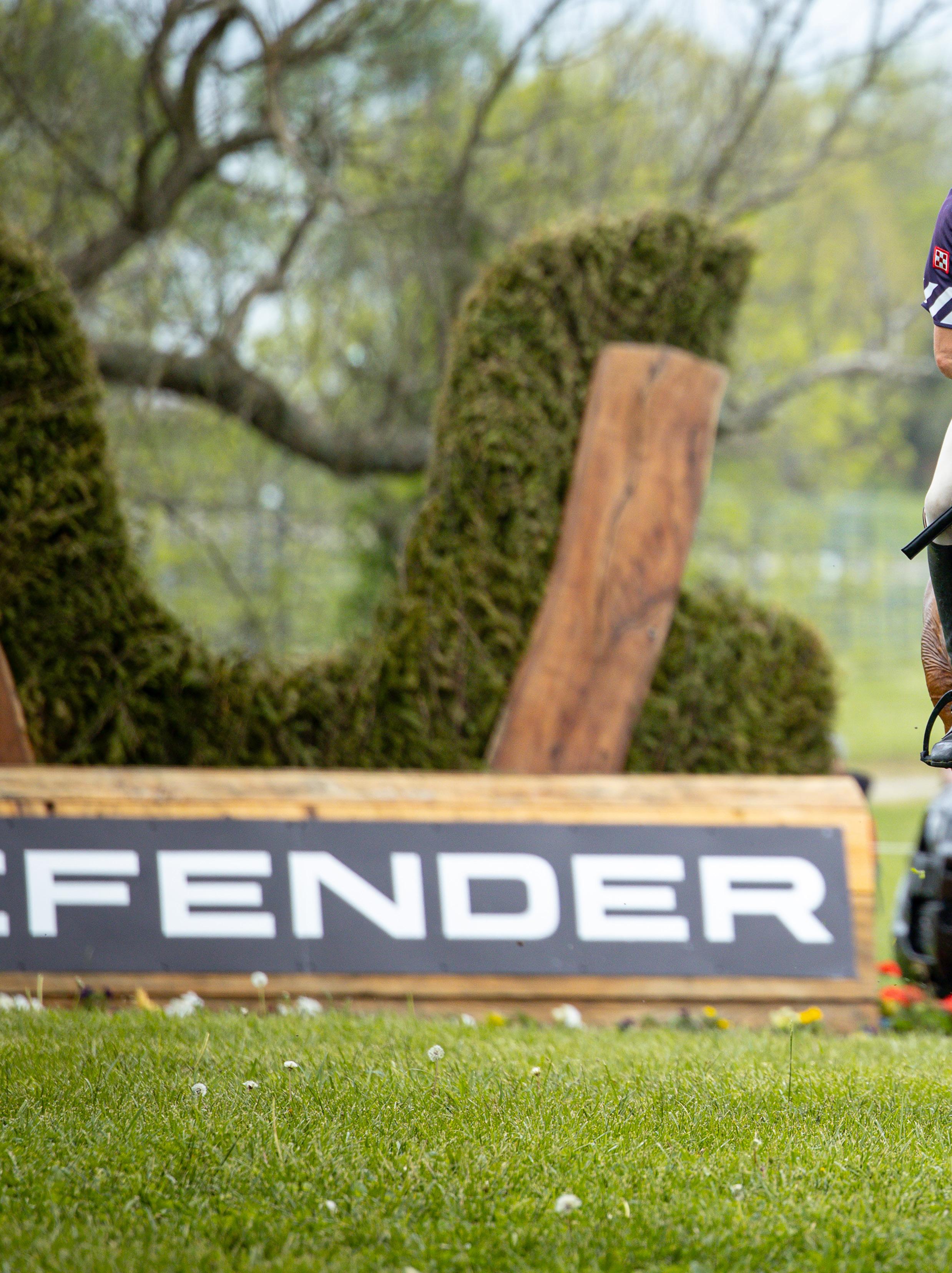



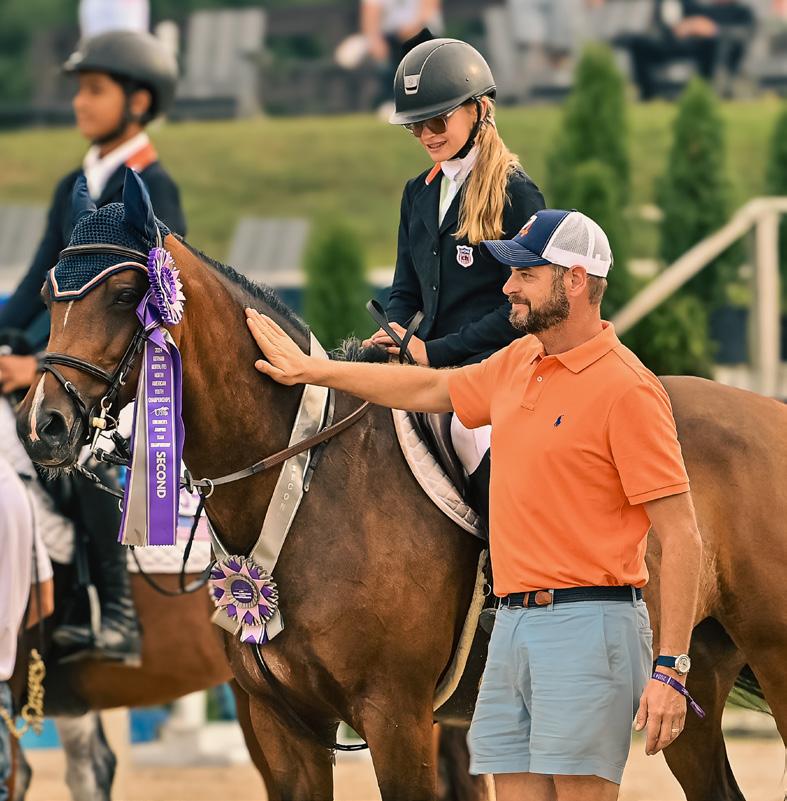
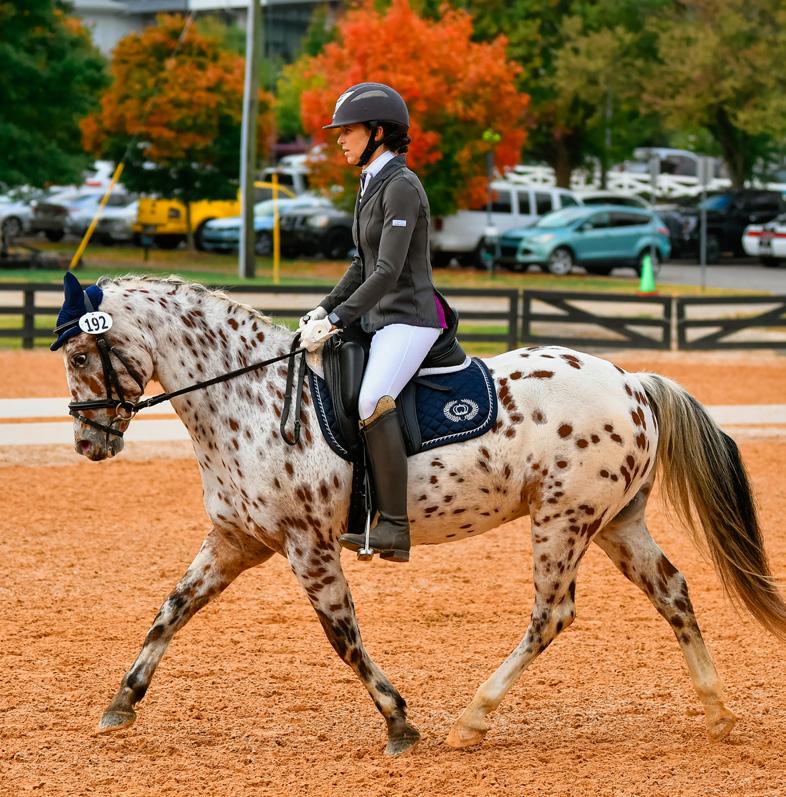




Official Magazine of the United States Equestrian Federation
US EQUESTRIAN MAGAZINE
Volume LXXXIX, Summer 2025
PUBLISHED BY
The United States Equestrian Federation, Inc.
CHIEF MARKETING & CONTENT OFFICER
Vicki Lowell | vlowell@usef.org
EDITOR-IN-CHIEF
Debbie Elliot | delliot@usef.org
CREATIVE DIRECTOR
Candice McCown | cmccown@usef.org
ADVERTISING DIRECTOR
Kim Russell | 859 225 6938 | krussell@usef.org
DIRECTOR OF SPONSORSHIP & SALES
Layson Griffin | lgriffin@usef.org
ASSISTANT DESIGNERS
Kendall Neubeiser, Kate Strom
EDITORIAL STAFF
Kim Russell
CONTRIBUTING WRITERS
Ashley Swift, Gianna Trotter, Helen Townes
Equestrian Magazine (ISSN 1548-873X) is published five times a year: Horse of the Year Special Edition, Spring, Summer, Fall, and Winter, by the United States Equestrian Federation®, 4001 Wing Commander Way, Lexington, KY 40511; Phone: (859) 258-2472; Fax: (859) 231-6662. (ISSN:1548-873X). NOTE: Effective Spring issue of 2018, Equestrian magazine will be published and provided electronically and only four editions will have printed copies and be provided by U.S. Mail. The Winter issue will only be provided electronically. The Horse of the Year issue will be mailed only to competing members as of the date of publication and the year immediately prior to the date of publication. USEF is not responsible for the opinions and statements expressed in signed articles and paid advertisements. These opinions are not necessarily the opinions of USEF and its staff. While the Federation makes every effort to avoid errors, we assume no liability to anyone for mistakes or omissions. It is the policy of the Federation to report factually and accurately in Equestrian and to encourage and to publish corrections whenever warranted. Kindly direct any comments or inquiries regarding corrections to Glenye Cain Oakford goakford@usef.org or by direct dial 859-225-6941. POSTMASTER: Send address changes to US Equestrian, 4001 Wing Commander Way, Lexington, KY 40511. Canadian Publications Agreement No. 40845627. For Canadian returns, mail to Canada Express, 7686 #21 Kimble Street Mississauga, Ontario, Canada, L5S1E9. (905) 672-8100. Reproduction of any article, in whole or part, by written permission only of the Editor. Equestrian: Publisher, United States Equestrian Federation®, Chief Executive Officer, William J. Moroney (859) 225-6912. Director of Advertising, Kim Russell (859) 225-6938. Copyright © 2024 Equestrian is the official publication of the United States Equestrian Federation, the National Governing Body for Equestrian Sport in the USA, and is an official publication of USEF.
Published at 4001 Wing Commander Way, Lexington, Ky 40511 USequestrian.org



The magazine staff is pleased to share these notable accomplishemnts it has received at the American Horse Publication Media Awards.
2024
First Place: Advertisement
Second Place: Editorial Design Honorable Mention: Editorial Design
2022
Third Place: Cover Design Honorable Mention: Feature Article
2021 Honorable Mention: Editorial Design
2020
First Place: Advertisement
Third Place: Editorial Design Honorable Mention: Editorial Design
2019
Third Place: Cover Design
2018
Overall Publication Winner
First Place: General Excellence
First Place: Editorial Design
Second Place: Feature Article
2017
Second Place: Digtial Publishing





A premier 10.32-acre equestrian estate, ideal for any riding discipline, featuring top-tier amenities: 25 stalls, a covered riding arena, outdoor jumping and dressage arenas, an exercise track, a Euro-walker, and a round pen. The property includes two barn apartments with a total of 8 bedrooms. The main residence is a stunning 8-bedroom pool home, offering five bedrooms on the first floor and a private three-bedroom lock-off apartment upstairs, complete with a full kitchen and living room. Offered at - $10,950,000





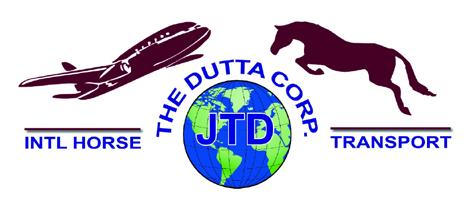


































$50,000 TO THE CHAMPION THE
SEPTEMBER 4-6, 2025
PLAN YOUR TRIP AND PURCHASE TICKETS TO THE CHAMPIONSHIP FINALS, SATURDAY, SEPT 6 - 4PM LEARN



Dear USEF Members:
Summer is the best time of the year for many equestrians as it brings long days for extra riding, and the excitement of the summer show season. This summer will be especially thrilling for fans of equestrian sports as competition heats up in the inaugural US Equestrian Open dressage and eventing seasons. Christian Kukuk and Checker 47 have already been victorious at the US Equestrian Open Jumping Final, who else will etch their names in history on the new US Equestrian Open trophy? I can’t wait to watch all the action on the USEF Network and ESPN, and we hope that you will too.
As the temperatures and humidity rates rise, we all need to be aware of the impact heat has on our horses while at competitions and at home. Our latest Vet’s Corner offers essential advice on how to recognize, treat, and prevent heat stroke in horses. A simple pinch test will show if your horse is dehydrated, and be sure to give them extra water — horses normally drink five to 10 gallons a day, but that can triple in extreme temperatures!
Another downside of summer is the heightened risk of wildfires due to hot, dry conditions. We all witnessed the devastation that wildfires caused in Los Angeles earlier this year, but fortunately, there is a lot that equestrians can do to be prepared in case of a fire-related emergency. This issue features first-hand accounts from people who were directly impacted by the Palisades and Eaton fires, as we hear their stories of bravery and resilience, as well as acts of generosity from the equestrian community. Also included in our feature is lifesaving advice on how to keep your horses, your barn, and yourself safe when threatened by wildfire.
A further display of heroism that saved a young rider’s life occurred when 14-yearold Ryan Haselden suffered a sudden cardiac arrest while competing. Thanks to the fast action of physician Dr. Karley Koch, who happened to be watching from the stands, Ryan survived and is now jumping again! Her experience highlights the need for people to be CPR-trained and for there to be AEDs on horse show grounds, which USEF strongly recommends.
In this issue, we also have the opportunity to celebrate all the wonderful breeds that can be seen competing in classic disciplines. From an OTTB excelling in the hunter ring, to Mustangs competing in eventing, and a spotted Pony of the Americas (POA) who is turning heads in the dressage arena — these talented horses are breaking the mold and proving that you don’t need to ride a traditional breed to succeed. To learn more about all the different breeds and disciplines that are USEF affiliates, be sure to check out our How It Works article, which explains the crucial role that the National Breeds & Non-FEI Disciplines Sport Department plays at US Equestrian.
Whatever your plans are this summer, whether it be competing, taking relaxed trail rides at home, or anything in between, I hope that you enjoy this golden season and are safe and successful in all your endeavors. See you ringside.

Tom O’Mara President

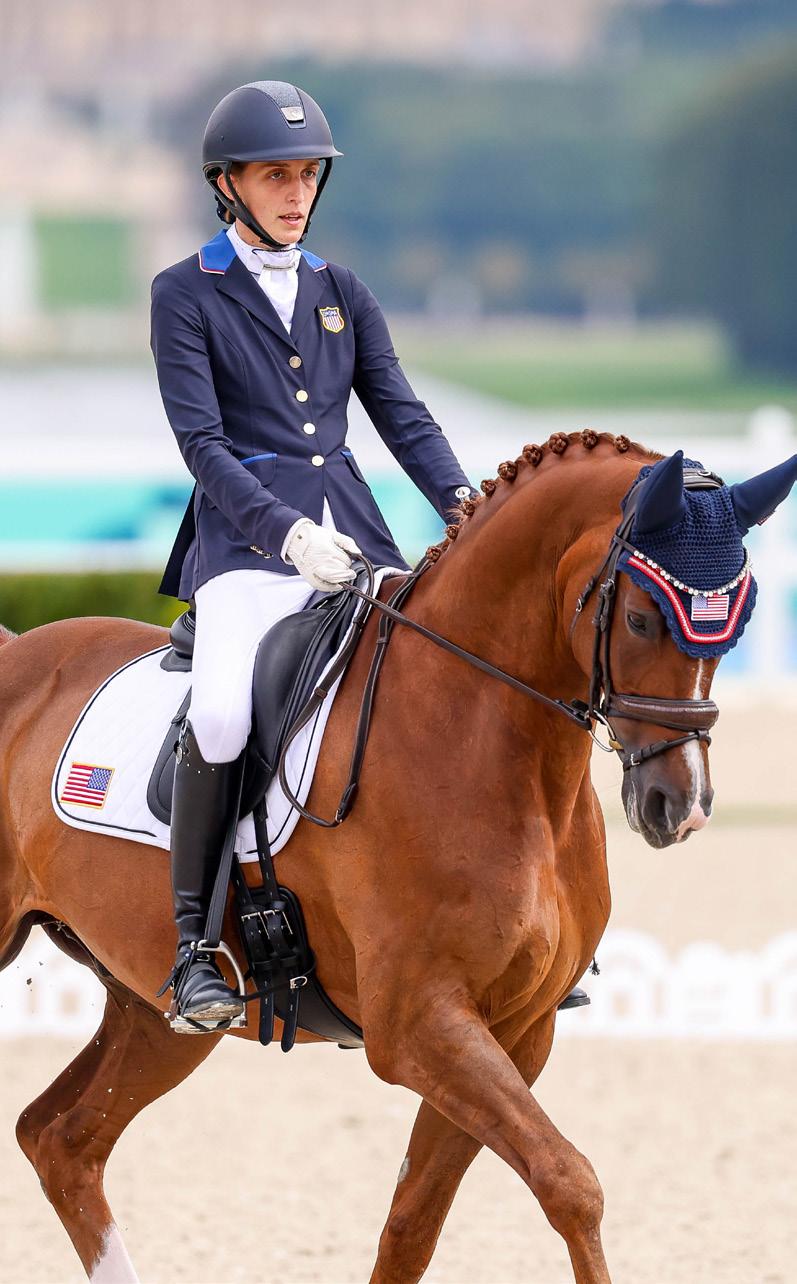



Throughout May 2025 for the first time ever, four U.S. athletes occupied the number-one spot in their respective discipline world rankings, with Kent Farrington moving into number one on the Longines FEI Jumping World Ranking List, and Boyd Martin earning the number one position on the FEI Eventing World Ranking List for the first time in his career. Fiona Howard still holds her position as the number one athlete in the world in the FEI Para Dressage Rankings. In addition, Ana Schult has topped the FEI Vaulting World Cup Ranking List for Females, to add to the United States’ accolades. The 26-year-old from Longmont, Colo., is coming off an impressive win at the Saumur CVI3* in France. Farrington last held the honor in 2018, while Martin’s jump to the top of the rankings is the first time a U.S. eventing athlete has held the honor in more than 20 years. For Farrington, his jump to the top of the rankings unseats Henrick von Eckermann (SWE), who held the coveted position for the longest span in history, with his reign beginning in August 2022. In the last year, Farrington has jumped 31 rounds at 1.60m, producing 15 clears, six wins, and 12 podium finishes, with a clear rate of nearly 50%.
Boyd Martin’s quest to world number one has been 25 years in the making. Martin has amassed more than 71 starts at the CCI5*-level throughout his career, producing more than 48 clear cross-country rounds, with an impressive 73% completion rate at the level. With three horses finishing inside of the top ten at the 2025 Defender Kentucky Three-Day Event presented by MARS Equestrian, Martin’s success has pushed him atop the list, marking the return of an American athlete to the forefront of the global rankings for the first time since Kim Severson in 2004. Martin remains one of the top cross-country athletes in the world, delivering more than 416 jumping clears throughout his career, and earning more than 56 international wins.
2024 Paralympian and triple-gold medalist from the Paris Games, Fiona Howard, still holds her spot as the number one athlete in the world in Para Dressage. After a breakout season in 2024, Howard has remained on top of her game so far this year for the U.S. Para Dressage Team, helping the team secure three-straight victories so far in CPEDI3* competition in the United States.




Michael Jung and fischerChipmunk FRH jumped to victory in the 2025 Defender Kentucky Three-Day Event, which marked the second K3DE win for the pair.
Michael Jung (GER) and fischerChipmunk FRH finished atop the podium for the CCI5*-L at the 2025 Defender Kentucky Three-Day Event on April 27. Meanwhile, Boyd Martin and Commando 3 completed the weekend as the top U.S. combination on the leaderboard, taking home the Defender/USEF CCI5*-L Eventing National Championship presented by MARS Equestrian™. The Cosequin Lexington CCI4*-S concluded with William Coleman and Off The Record clinching the top spot, marking Coleman’s second victory at the event in two years. Jung and fischerChipmunk FRH, individual gold medalists at the 2024 Paris Olympic Games, added another win to their trophy case by the end of the show jumping phase of the CCI5*-L. The pair had one rail down as the final combination in the class order, but were still able to secure their win, finishing within the time allowed, and bringing their final weekend score to 25.0. It marked Jung’s fifth K3DE win and a second for fischerChipmunk FRH. “It’s something special,” said Jung. “I really believe in my horse and in this place. I always had a lot of luck here; without luck you win nothing.” Martin pulled triple duty once again in the CCI5* finale. He was the first to contest the CCI5*-L show jumping track, designed by Steve Stephens, notching a clear round aboard Luke 140, a 2011 Holsteiner gelding owned by the Luke 140 Syndicate, earning an overall seventh-place finish and the pair’s second consecutive top-10 finish at the CCI5*-L level. His tidy round aboard Luke 140 set up a stellar performance with fan-favorite Fedarman B, a 2010 KWPN gelding owned by the Annie Goodwin Syndicate, who showed off his impressive scope and power, adding just 0.4 to their score, finishing in sixth overall on a final three-phase score of 40.6. Martin concluded the day with Commando 3, a 2013 Holsteiner gelding owned by Yankee Creek Ranch, who held second place overall heading into the final phase. The pair jumped a spectacular double clear, rewarded with a roar from the crowd filling the stands in Rolex Stadium. In the pair’s first CCI5*-L finish as a combination, they completed the weekend on a final score of 32.8.
“To be honest, I wasn’t sure what I was in for this weekend,” Martin said. “Commando 3 [Connor] was my Direct Reserve horse for the Olympics last year. After going through this event, I think he could be a career-changing horse. He’s got such quality, he’s beautifully bred with plenty of Thoroughbred, and he’s strong in all phases. I think this is just the beginning.”
British rider Harry Meade and Et Hop du Matz took home third place overall after they jumped double clear on the final day to finish as the only partnership in the CCI5*-L division to add nothing to their original dressage score of 34.2.
Martin’s trio of horses finished 1-2-3 in the Defender/USEF CCI5*-L Eventing National Championship, earning Martin the third National Championship win of his career at the CCI5* level.
Derived from a plant seed oil comprised of fatty acids, Epiitalis®. is the world-exclusive active ingredient powering 4CYTE™. Epiitalis® is globally patented for its ability to help maintain healthy cartilage growth.





Why horse owners love 4CYTE™ Epiitalis® Forte Horse
Supports normal joint function, mobility, and flexibility
Eases joint stiffness due to normal daily exercise and activity
Helps maintain healthy cartilage development
Helps maintain the health & resiliency of joints and connective tissue
May help address occasional gait irregularity & unwillingness to travel forward
Helps maintain a normal inflammatory response
* Guaranteed for palatability, or your money back.
Santa Anita Park, in Arcadia, Calif., has been confirmed as the venue of the equestrian events of the Olympic Games Los Angeles 2028. “Santa Anita Park will be a spectacular venue for the LA28 Olympic equestrian events,” FEI President Ingmar De Vos said following the announcement. “The FEI has very fond memories of Santa Anita, which hosted the equestrian events at the 1984 Olympic Games. The venue is set to offer a breathtaking stage for all the Olympic equestrian competitions and the proximity to LA City will undoubtedly attract many spectators to Santa Anita. We look forward to continuing our cooperation with LA28 to
deliver spectacular equestrian events at the 2028 Games in Los Angeles.”
“I would like to thank the FEI on behalf of the IOC for the active engagement in all the discussions regarding the venue,” IOC Sports Director Kit McConnell said. “We have created a strong partnership with the Organizing Committee and the city of Los Angeles, which enjoys the full support of the local equestrian community.”
“We have the utmost confidence in the LA28 Organizing Committee, and we anticipate exceptional equestrian sport will take place at this special legacy venue from the 1984 Olympic Games. We are also extremely pleased

that the IOC has confirmed the athlete quotas across the disciplines for 2028 and they remain unchanged from 2024,” said Bill Moroney, Chief Executive Offi cer of US Equestrian.
Santa Anita features an on-course veterinary clinic and has hosted some of the major Thoroughbred events in the USA including the Breeders Cup. The venue is also famous for being the track where champion Thoroughbred racehorse Seabiscuit won his last race in 1940. The facility recently hosted a CSI3*, along with an FEI Jumping World Cup™ Quali fier CSI5*-W, which will take place again in November 2025.
Santa Anita covers 130Ha (320 acres) and includes a 340m-long (1,100-foot) grandstand that seats 26,000 spectators. The track infield area, which resembles a park with picnic tables and large trees, can accommodate a crowd of 50,000. The Park has 61 barns that can house more than 2,000 horses.


In June, the LA28 Organizing Committee for the Olympic and Paralympic Games announced that the Para Equestrian events will also be held at Santa Anita Park. The LA28 Olympic Games will take place from July 14-30, 2028, and the Paralympics are scheduled from Aug.15-27, 2028.
US Equestrian has developed new guidelines regarding returning to equestrian sport (in the saddle, on the ground, or driving) following a concussion. Please note, these guidelines are recommendations only and are not intended to replace advice from an athlete’s own medical provider. The Return to Sport (RTS) guidelines provide information for the parents, guardians, trainers, friends, and barn mates of anyone suffering from a suspected concussion to help with monitoring their health and behavior following a fall or accident.
The strategy is a six-step process spanning from the time of the concussion to the return to competition, and each step
should be separated by at least one to two days. If the athlete is younger than 18 years old, then a longer recovery interval between each step is recommended.
Step 1: Initial Recovery
Step 2: Light Physical Activity
Step 3: Unmounted Equestrian-DisciplineSpecific Activites
Step 4: Return to Light Equestrian-Discipline-Specific Riding or Activities
Step 5: Full Practice
Step 6: Return to Competitive Equestrian-Specific-Discipline
At Step 6, a medical release form must be submitted by the athlete and signed by a medical provider to return to USEF competition.
It is essential to note that not all concussions are apparent at the time of injury, so people should pay close attention to the signs and symptoms of a concussion for 24 to 48 hours after an accident or fall. In addition, each individual’s symptoms and recovery timeline are unique, and should always be discussed and determined by a medical provider. For more information, please visit usef.org/forms-pubs/kzMxQoKQr0E/ equestrian-specific-return-to-sport.
Above: U.S. Jumping Team silver medalists Karl Cook and Caracole de la Roque at the 2024 Paris Olympic Games.







US Equestrian has released the 2025 Drugs and Medications Guidelines, which includes important updates for members.
“The USEF Drugs and Medications Guidelines equip trainers with necessary information to help ensure adherence to regulations, thereby promoting fair competition and preserving the integrity of the sport,” said Sonja Keating, Chief Operating Officer and General Counsel at US Equestrian. “It is a resource provided to raise awareness about the implementation of new rules and compliance with existing rules.”
The 2025 Drugs and Medications Guidelines are available for download at usef.org/compete/regulation/drugs-medications .
Dr. Stephen Schumacher, Chief Veterinary Officer and Chief Administrator of USEF’s Equine Drugs & Medications Program, reminds members that if they have any specific questions that are not answered in the guidelines, they should call 800-633-2472 for direct assistance.
“We would much prefer to educate than to adjudicate. We appreciate people calling and asking any questions they have; that is what we are here for,” Dr. Schumacher said. “The Drugs and Medications Guidelines provide guidance for our members on how to comply with the rules and still compete their horses. Obviously, the welfare and the best interest of horses is paramount,” he added.
“The first half of the guidelines document consists of practical advice on how to comply, and the second half is the General Rule 4,” Dr. Schumacher explained. The most significant changes in the 2025 guidelines are in the Prohibited Practices section, most notably GR414.4, which states that only a licensed veterinarian is permitted to administer Shock Wave therapy on the grounds of a USEF competition.
GR 414.8 and 414.9 are also important updates, said Dr. Schumacher. “GR414.8 addresses the prohibition of certain substances. It is now a violation of the rules to be in possession of these injectable substances at a competition, not just for their use. GR414.9 is a prohibited practice for rectally administering any medication or any substance on the grounds of a Federation competition,” he explained.
In addition, “the Altrenogest rule update is notable as it is now prohibited in stallions and geldings but will still be permitted in mares,” Dr. Schumacher continued. According to the 2025 guidelines: “The use of any progestogens in stallions and geldings while competing in USEF-licensed competitions will be considered prohibited under Chapter 4 of the USEF rulebook. Altrenogest, known as Regu-Mate® commercially, is the FDA-approved synthetic progestogen commonly administered to mares to suppress estrus and the associated seasonal behaviors, and to aid in breeding practices for broodmares. While alternatives exist for males (gelding), surgical removal of the ovaries is not as easily accomplished as in other species. Altrenogest provides a means to normalize mares during estrus. Altrenogest will continue to be permitted to be used in mares under Federation rules.”
The full USEF 2025 Guidelines and Rules for Drugs and Medications can be found on usef.org/forms-pubs/2Zp2C_YKs4s/2025equine-drugs-medications or by scanning the QR code above.

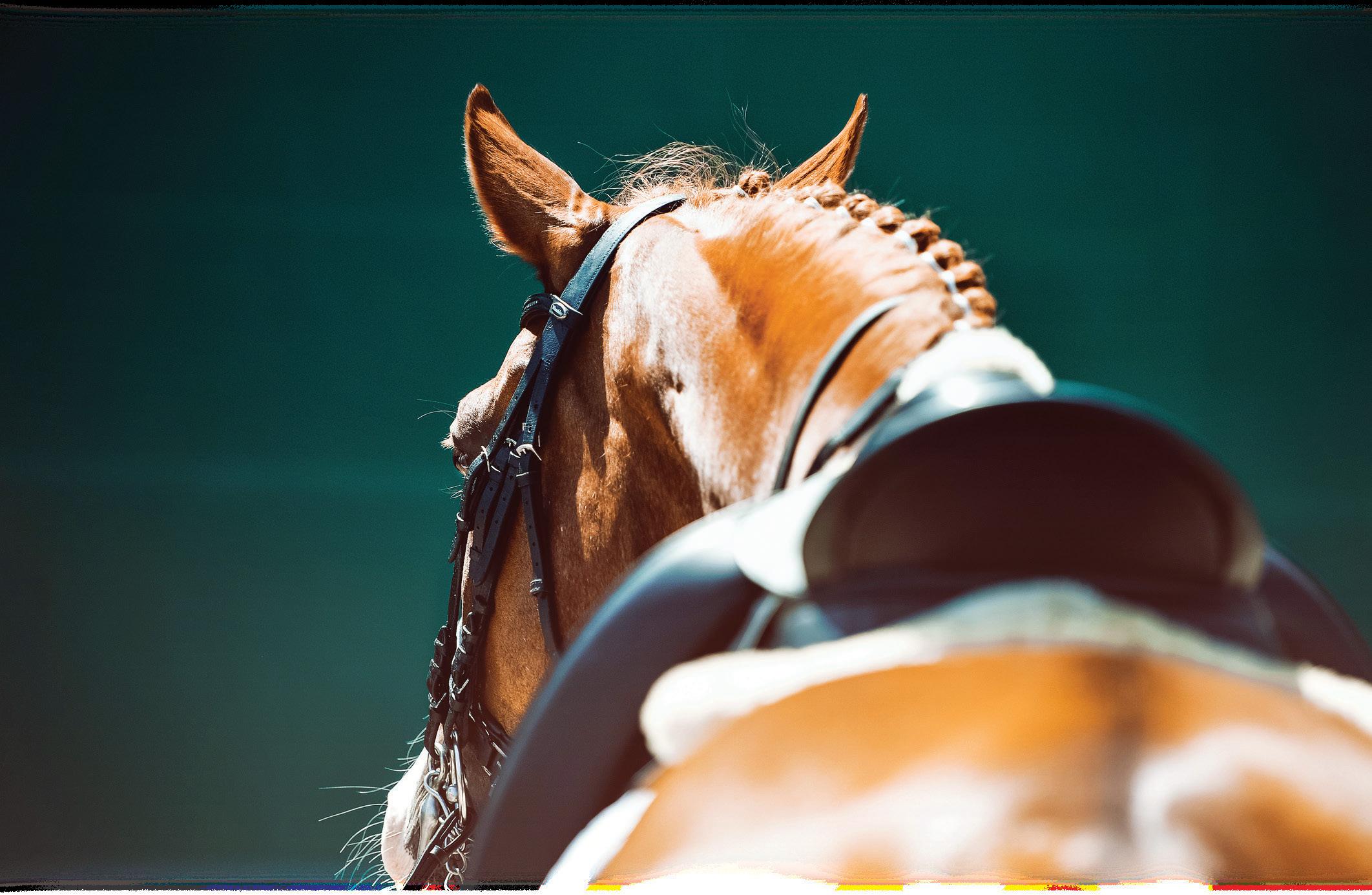

Challenge:
Dehydration, electrolyte depletion
Solution: Summer Games® Electrolyte
• Replenishes the electrolytes and trace minerals lost during sweating.
• Stimulates the thirst response to keep horses drinking.
• Supports quick recovery after competing in hot, humid conditions. Satisfaction guaranteed.
“B
eing a disabled woman, the world often tries to pigeonhole me into specific roles. Equestrian sport was the place that I first felt and experienced equality.”
- Paralympian and U.S. Para Dressage Team member Rebecca Hart.
Clockwise from this page: Kimmy Palmer and Rosenstalz 99 captured in the FEI Vaulting World Cup Final in April with a beautiful freestyle performance.
Canadian rider Jessica Phoenix during a warmup ride on her eye-catching mount, Fluorescent Adolescent, ahead of the 2025 Defender Kentucky Three-Day Event.
Young fans enjoyed their LeMieux horses while watching the Cosequin Lexington CCI4*-S showjumping phase of the 2025 Defender Kentucky Three-Day Event.
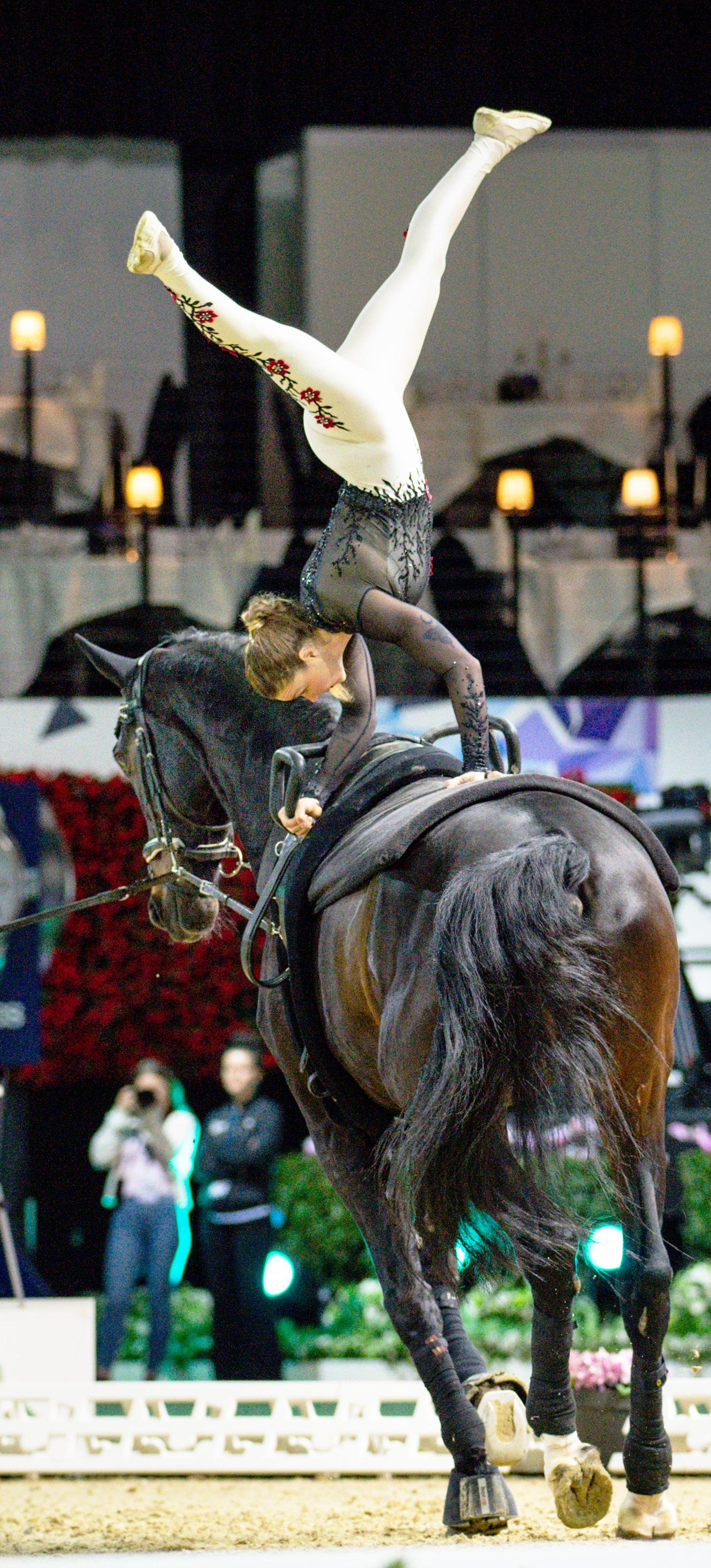

“T
his is an honor not only for me, but also for my team and everyone who helps support me in this sport…I’ve been riding most of my current horses since they were seven years old or younger and I really enjoy the process of developing them. It’s a rewarding journey and I’m excited to see where we can go from here.”
- Kent Farrington, after moving into number one on the Longines FEI Jumping World Ranking List.

“T hey’re incredibly intelligent athletes. They’re wonderful students. Once they figure out who you are and trust you, they’re willing to do anything for you.”
- Amanda Burriel on Connemaras when the breed was showcased at the Chewy Demonstration & Exhibitions
Ring during the 2025 Defender Kentucky Three-Day Event presented by
MARS EquestrianTM
Glorious
summer days at the barn can bring with them the risk of heat-related stress and other health issues for your horse.
by Debbie Elliot
Summer is officially here! Whether you live in dry Southern California, hot and humid Florida, or somewhere in between — temperatures are guaranteed to be on the rise. All equestrians need to be aware of the effect of severe heat conditions on their horse to avoid heat stroke and other related ailments.
“In a hot environment, you want to monitor your horse for an elevated temperature, increased breathing, or increased pulse,” said Dr. Katie Flynn, BVMS, Senior Veterinarian Equine Health and Biosecurity at US Equestrian. “The heat exhaustion symptoms in a horse can be similar to that of a human,” she added.
A simple test to see if a horse is dehydrated is to pinch the skin along the horse’s neck and monitor how long it takes to return to normal. “The skin should go back right after you pinch it. If it stays standing up or slowly releases (taking more than five seconds to return to normal), then they are dehydrated,” Dr. Flynn said. The gums are also an indication of hydration. Normal gums will be soft and pink and will return to their natural color within two seconds of being pressed. If they are slow to go back to normal, your horse might be dehydrated. In addition, check to see if your horse’s mucous membranes in their nose and mouth are dry or red, as that is another sign of dehydration.
Abnormal behavior is also an indication of dehydration or heat stroke. “Look for them acting tired, showing a change of behavior, stumbling, and overall weakness,” Dr. Flynn said. If your horse is not interested in his food, or has droopy ears, that can also be a sign that there is an issue.
Monitoring your horse’s urine can provide additional insight into hydration levels — the darker the urine, the more dehydrated they are. Clear urine shows good hydration, while orange or tea-colored urine signifies severe dehydration. A horse’s manure is an insight into what is happening in their gut. Dry or hard manure can indicate dehydration or impaction.
If you notice that your horse is overheating after exercise, you should remove the tack, take them to a shaded area and cool them with cold wet towels or ice packs until you can slowly get their temperature back down, advises Dr. Flynn. If the temperature goes above 101.5 Fahrenheit, it is not coming down quickly (within 15 to 20 minutes), or you are still seeing an increase, consult your vet immediately, she stated. Horses’ normal resting temperature is 99 to 101.5 Fahrenheit, but can rise by 1-2 degrees


In July 2024, US Equestrian released recommendations for competing in hot conditions, based on the American Association of Equine Practitioners (AAEP) heat index guidelines. Please note, the National Weather Service scale and the AAEP scale for heat index are not equivalent measurements. The (AAEP) heat index is based on the temperature plus relative humidity.
US Equestrian recommendations for participants at competitions:
• All parties are responsible for evaluating their specific situation and taking necessary steps to ensure healthy and safe competition.
• If the total (temperature + humidity) is below 130, you can enjoy the competition.
• When the number (temperature + humidity) falls between 130 and 150, you should begin to monitor for potential signs of heat stress in the horse.
• When the number (temperature + humidity) falls between 150 and 180, it is critical to monitor the horse for signs of heat stress.
• If the number (temperature + humidity) is above 180, US Equestrian encourages alternative competition times.
If you are bringing your horse to a hotter or more humid climate to compete than what they are used to, be sure to give them time to acclimate to the temperature change. Ideally, 15 to 21 days of exercising in the cooler parts of the day before strenuous activity will allow them to get used to the weather and develop heat tolerance.


with exercise. Above 105 Fahrenheit is considered to be a warning sign for heat stroke. However, every horse has their own normal temperature range, so it’s important to check your horse’s temperature regularly to establish a baseline. In addition, a healthy respiratory rate is 10-24 breaths per minute, with a heart rate range of 28-44 beats per minute.
A reliable way to regularly monitor your horse’s temperature is by implanting a Bio-Thermal microchip. Along with being a permanent identifier for your horse that cannot be altered, Bio-Thermal microchips have the added advantage of containing a patented built-in temperature biosensor, offering quick and easy temperature reading when scanned.
When your horse is in its stall on overly hot days, make sure there is sufficient ventilation and a powerful barn fan (avoid indoor house fans as they are a fire hazard). You can also place your horse directly under a fan if they are overheated. A misting system, especially when installed in an area of the barn with good air flow, can reduce the temperature in the area by 20 to 30 degrees Fahrenheit.
To avoid dehydration, “ensure that your horse has access to a constant supply of fresh, clean water, which will encourage them to drink more,” said Dr. Flynn. Horses normally drink 5 to 10 gallons of water per day, but that can double or triple in extreme temperatures. Change water often to keep it fresh, use smaller buckets so that it is not sitting in the sun, and bring water and buckets from home when traveling so they are familiar to your horse and don’t taste different.
Endurance and eventing horses often have full buckets of water poured over them for rapid cooling at competitions. Horses normally drink 5 to 10 gallons of water per day, but that can double or triple in extreme temperatures.
Veterinarian Developed
Addresses health at the cellular level with a digestive and joint focused approach
Thousands of hours of research and clinical trials in each bucket
High-quality ingredients in the most bioavailable form for your horse
Platinum Colic Coverage®
Eligible up to $15,000


Platinum Performance® DJ is an innovative one-bucket solution to horse health and longevity. This veterinarian-developed formula combines the benefits from Platinum Performance® Equine with probiotics and yeast extracts that support intestinal integrity and immune health. Additionally, this formula introduces a novel combination of tamarind and turmeric extracts that maintains healthy levels of inflammation and provides powerful joint nourishment. See the difference one bucket can make.
A combination of probiotics, prebiotics, postbiotics and glutamine
seed and turmeric root extracts for joint flexibility
Anhidrosis is the inability to sweat, and typically affects horses living in warm, humid climates such as states along the Gulf Coast of the U.S. Anhidrosis can either develop slowly over time, or come on rapidly. Horses suffering from the issue will show signs of an increased respiratory rate — and possibly even respiratory distress — as they work to lose heat through their respiratory tract. Heart rate and blood pressure may both be above normal, while core temperature will remain elevated. Horses with extreme conditions can develop dry, flaky skin, or their coat may become thin.
The ideal solution for anhidrosis is to move the horse to a cooler, less humid climate, but that is not always possible, and some horses still suffer even in cold environments. A temperature-regulated stall is another great option, but that is also not financially viable for all horse owners.
The symptoms of anhidrosis can be treated through nutritional support, however. Anhidrotic horses often begin to sweat after treatment with electrolytes that contain sodium and potassium chloride, which are lost when horses sweat normally. Natural antioxidants such as vitamin E and vitamin C can limit the damaging effects of free radicals and other products of cellular oxidation caused by extreme heat stress, while B vitamins help to support normal cellular function. Arginine, an amino acid, is an important nutrient in the formation of nitric oxide synthase, and supplements containing arginine can encourage normal sweating in some horses. Platinum Performance® recommends using Platinum Refresh® in conjunction with one of the foundation formulas — Platinum Performance® Equine, Platinum Performance® GI, Platinum Performance® DJ or Platinum Performance® CJ — to support a horse’s ability to sweat properly and maintain a healthy body temperature.
Electrolytes can also help horses replace minerals lost through sweating. Horses need an ounce of salt a day in normal conditions, and that can double in the summer. Read the ingredient label as salt should make up at least 75 percent of the ingredients, while brands with added sugars should be avoided. Give your horse the electrolytes with their feed or wait until after they have eaten to administer to avoid ulceration. You can incorporate additional salt into their diet with a salt block, loose salt, or spraying feed down with salt water.
The time of day that you ride your horse can have a dramatic effect on heat exhaustion. Just as you wouldn’t want to go jogging in the heat of the afternoon, neither does your horse. Time exercising to the early hours of the morning or the evenings, and avoid the hottest part of the day between 2 p.m. and 5 p.m. If you have to ride when it is hot, reduce the workload, take frequent breaks in the shade, and offer your horse water every 30 minutes. After your ride, make sure you do a thorough cool down until breathing is back to normal and your horse has stopped sweating.
A cooling bath is always a refreshing experience on a hot day and will bring your horse’s core body temperature down. “You can also pour full buckets of water over the horse to cool them, which is what people often do in endurance and eventing competitions to encourage rapid cooling,” Dr. Flynn said.
Aside from heat stroke, the bright summer sun can be especially dangerous to pale-skinned horses and those with pink noses or bald faces as they are prone to sunburn. This can be prevented in a similar manner to with people — by covering their sensitive skin with a UV protection fly mask or by administering sunscreen. You can use human brands as long as they don’t include para-aminobenzoic acid or PABA. A sunscreen stick is easy to apply to the nose area and can be kept in your grooming kit.
Your horse should have access to a constant supply of fresh, clean water to encourage them to drink more.


Scan to learn more!

OneControl ® mobile integration, powered by a Bluetooth-enabled system, offers real-time monitoring and updates for comprehensive vehicle safety and peace of mind

Featuring a triple-axis, motionsensing accelerometer to deliver smooth and precise braking when the unexpected happens.
This system allows you to monitor tire pressure and temperature as you tow in real-time, helping you to stay aware and safe.
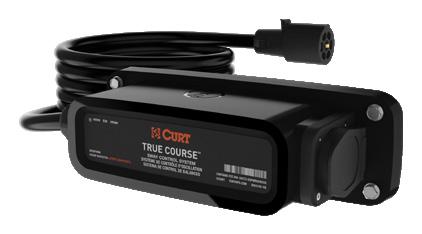
Emergency braking system combats sway caused by side winds, slippery roads and sudden movement.
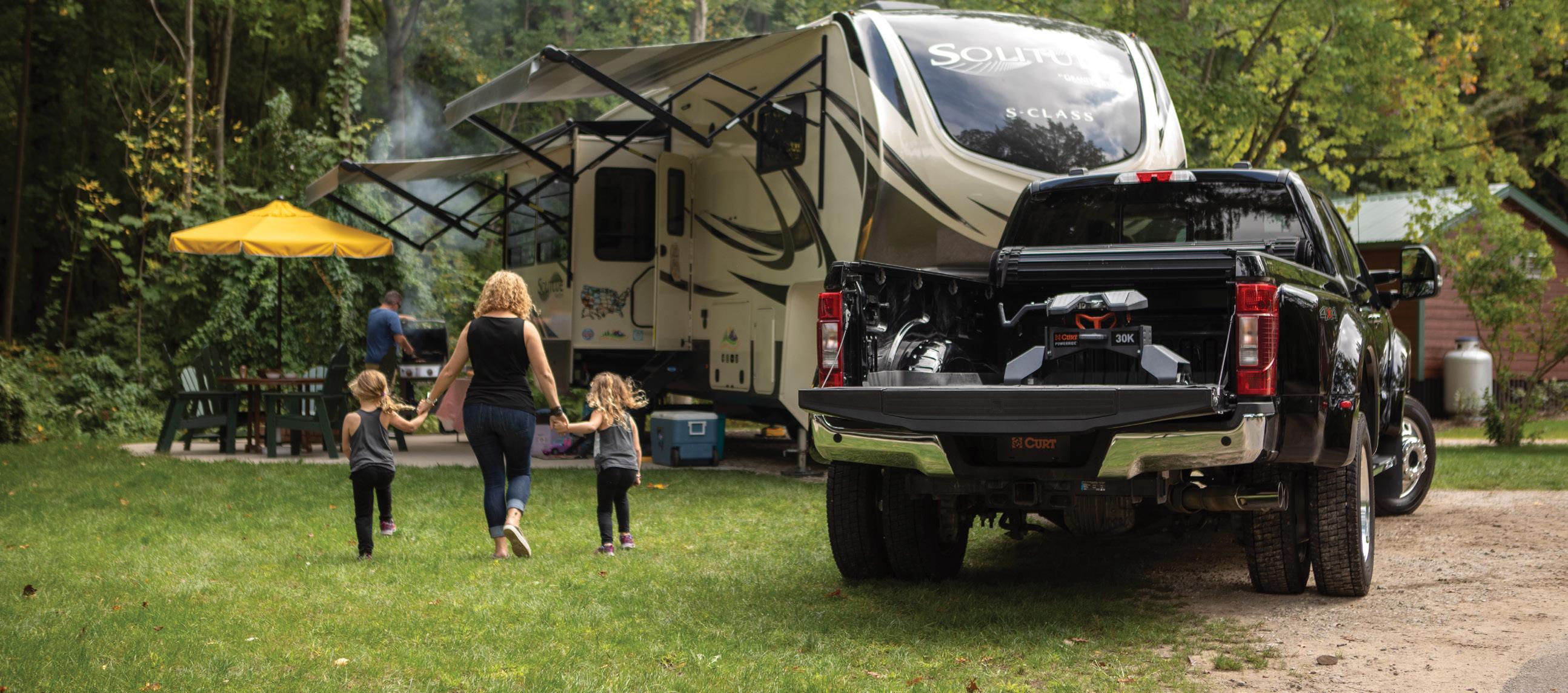
by Gianna Trotter

Gianna Trotter suffered a traumatic brain injury when she was one year old. Now 28, she is competing against ablebodied riders in the jumper ring and hopes to inspire others to do the same.
A week after my first birthday, my mom and I were on the highway and had a serious accident. My mom suffered a few broken ribs, but I had a traumatic brain injury. We were taken to the Jersey Shore University Medical Center in Neptune City, N.J., where I spent two weeks in a coma. I don’t remember anything before the accident or about that time in my life.
The car hit me in the front of the left side of my brain. The left side of the brain controls the right, and the right side of the brain controls the left, so I have full use of my left side but limited function and increased muscle tone on my right. Fortunately, my traumatic brain injury did not cause mental issues or memory loss, but I’ve always walked with a limp on the right side, and I can’t straighten my right arm.
The first few years of my life were spent doing in-patient occupational and physical therapy. The doctors said I wasn’t going to be able to walk or talk, or to live a normal life. I guess I grew up with the mentality of “let me try it.” I know a lot of people who give up in those situations as they remember what they could do before their accident, but that was not my case.
When people ask me “how do you cope?” I tell them that I grew up only using my left hand. I have a lot of faith, and I knew from a young age that everything happens for a reason.
A part of my therapy growing up was hippotherapy and that first introduced me to horseback riding. It was thought to be good for my muscles, balance, and overall mental health. I got to the trot when I was 12 years old, but I never went beyond that. I didn’t ride all the time; it would be once a week in the summer but then in the winter, my muscles would get really tight because of the cold weather in New Jersey. I did a walk-trot show but stopped riding after that as my dad got spooked when the horse went into a really fast trot. I don’t appear to be as agile or able as I am, so he got nervous with me being around horses. My mom was a little afraid too, but she’s better now.






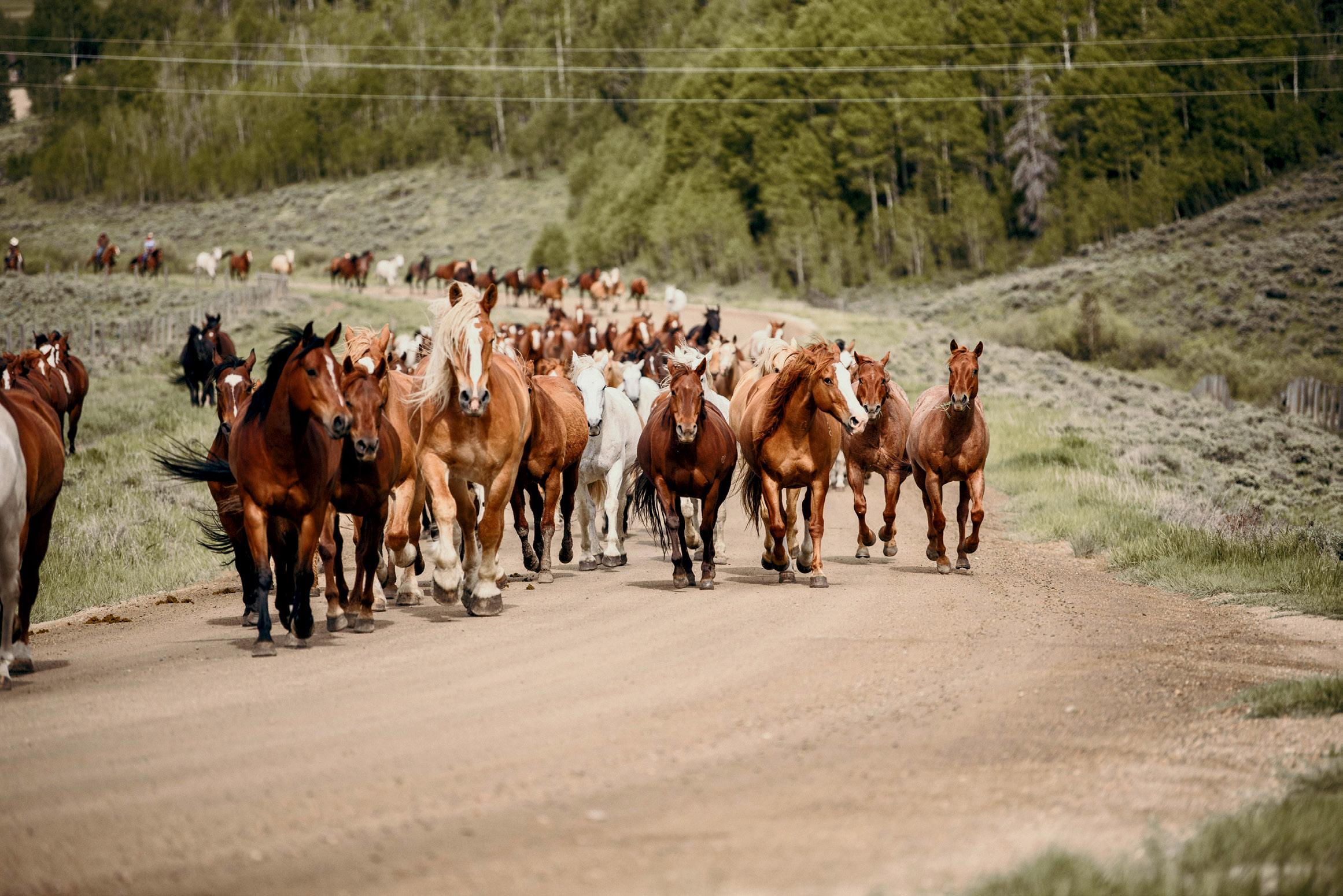

Tucson, Arizona
ElkhornRanch.com
Horseback riding and hiking for all ages and levels of experience. Personalized hospitality for 32 guests. Open November through April. Established by the Miller family in 1945.




WesternPleasureRanch.com ▪ (208) 263-9066
Experience the heritage, horsemanship, and heart of the true West in beautiful North Idaho. We specialize in personalizing your dude ranch stay to fit you. Relaxing or riveting; it’s all up to you. Sandpoint, Idaho
Discover Red Horse Mountain Ranch, Idaho's premier all-inclusive getaway with thrilling adventures, cozy lodging, and award-winning hospitality. Enjoy unforgettable fun for the whole family, from kids’ programs to guided outdoor experiences. Harrison, Idaho
RedHorseMountainRanch.com ▪ (208) 689-9680

At Bar W Guest Ranch, adventure meets serenity. Nestled near Glacier National Park, enjoy horseback riding, campfires, and cowboy culture in a setting that feels like your home away from home. Whitefish, Montana
TheBarW.com ▪ (406) 863-9099
TheHideout.com ▪ (307) 765-2080
Luxury Wyoming riding and horsemanship ranch. Caring, professional and mindful family operated hospitality experience. Limited to 25 guests. Acces to 650,000 acres, elevations ranging from 4200 to 10,000 ft in rarely seen variety of terrain. Shell, Wyoming

KlondikeRanch.com ▪ (307) 684-2390
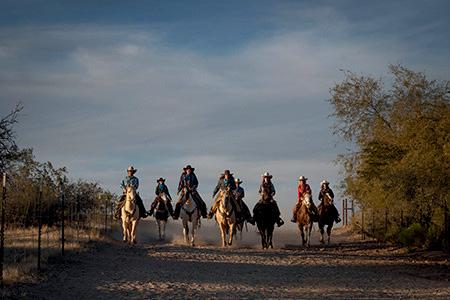
We’re a working guest ranch now welcoming children in June. We also offer fishing, hiking, historic sight-seeing and overnight camping in the Bighorn Mountains. Come ride Wyoming with us at Klondike Ranch! Buffalo, Wyoming

RanchodelosCaballeros.com ▪ (928) 684-5484
Picture yourself on a romantic horseback ride with wine and cheese or getting a relaxing massage at the Spa. We’re celebrating our 75th season showcasing an exceptional genuine western ranch experience. Wickenburg, Arizona
RockingZ.com ▪ (406) 465-5534
A family ranch that prides themselves in history, hospitality, and horsemanship. Enjoy sharing our love of Natural Horsemanship, great rides, and learning together in a beautiful peaceful setting. Wolf Creek, Montana
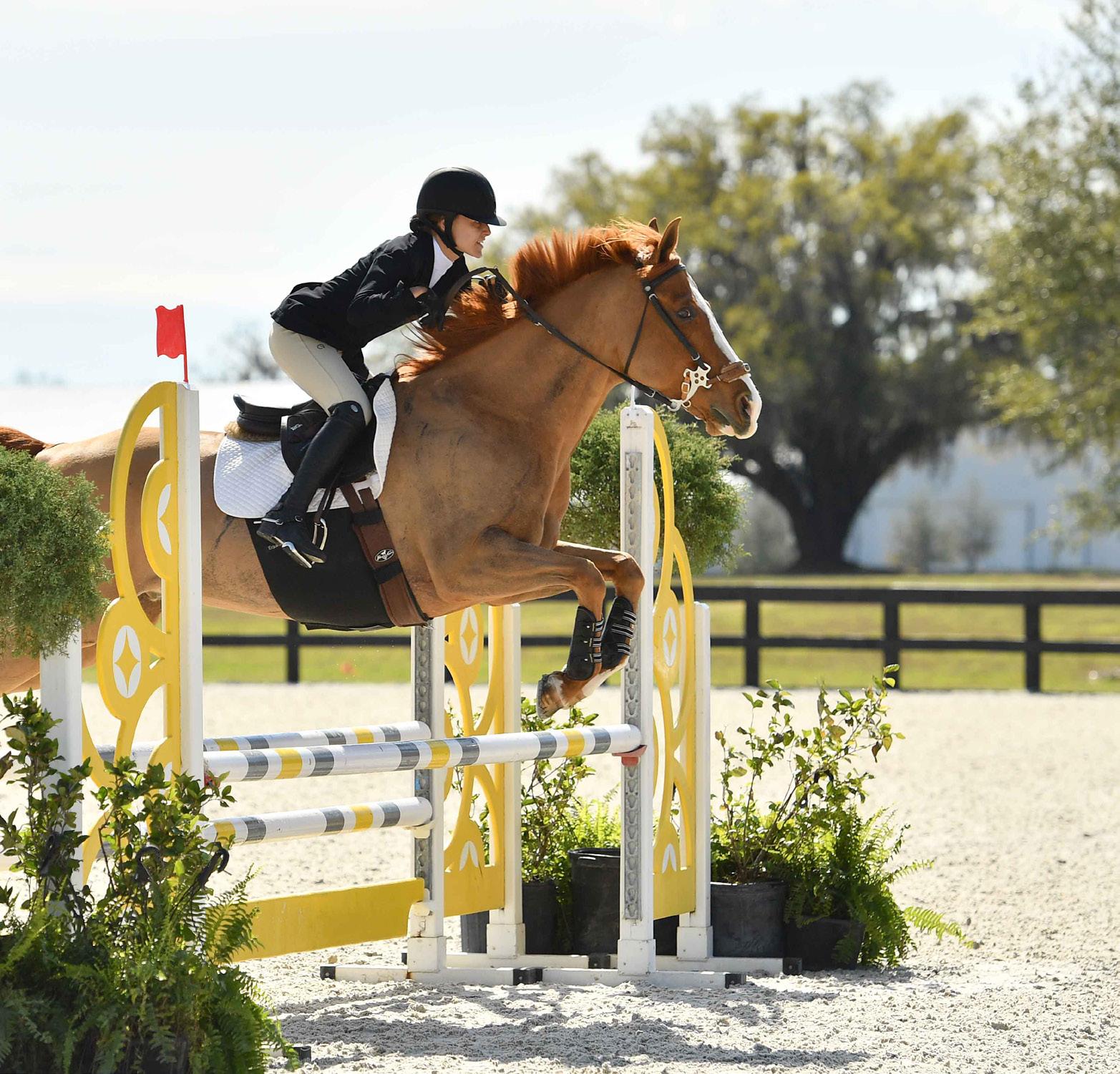
“ I HAD NO IDEA THAT THIS WOULD BE MY LIFE PATH OR MY PURPOSE, EVERYTHING JUST FELL INTO PLACE.”
In high school, I went to Hawaii and there was a horseback ride up the mountains, which I was really excited to do. At the time, I loved to travel so my goal then was to go to every single country and horseback ride. I didn’t even know there were equestrian sports like jumping, I thought there was just riding! I came back from Hawaii with the intention of taking riding lessons for the sole purpose of being able to canter in another country. In my first-ever proper riding lesson, I met Ziggy. I don’t know if it was his chestnut color that appealed to me, or because he was just so sweet — but I just clicked with him right away. He was a 19-year-old Appendix, who was experienced, wise, and took care of me. I started riding twice a week because I loved it so much, but I went to the barn literally six days a week to spend time with Ziggy. I had never felt anything like the connection with him before.
When Ziggy took me over my first cross rail, I was instantly hooked. It was the feeling of a lifetime, but it also confirmed the partnership that I had with Ziggy. I continued taking lessons and then found out that Ziggy’s owner was putting him up for sale. I thought, “He can either be in my life forever until the day he dies, or I’ll never see him again and wonder what if.” So, I bought him.
I had no idea that this would be my life path or my purpose, everything just fell into place. I had dreams of owning a horse when I was little, but I didn’t think it would be realistic until I could spend every waking second with them out in my backyard. I thought I needed to be retired to do that, instead, I became a horse mom at age 20.
I went on to train with Neal and Elisa Shapiro [who competed on Olympic teams for the U.S. and Mexico, respectively], and it turned out that they trained Ziggy seven years before I even met him, so they knew how he acted. They took me through my first show season in 2019, and we got fourth place overall for the year at our home horse show, Princeton Show Jumping in New Jersey. I could never take the training I got from Neal and Elisa for granted, and I would not be in the position I am in right now had it not been for them. I’m so grateful as they taught me a really solid foundation — how to feel the horse and what the horse needs, but also how I can be a good rider and adjust to different horses. We experimented a bit because I couldn’t ride traditionally, or by tying a knot in the reins because they would slip out.
“I got my love for jumping back. This horse has been a godsend,” Gianna said of her Appendix gelding, Casey.

“I GUESS I GREW UP WITH THE MENTALITY OF ‘LET ME TRY IT.’ ”
We visited Lizzy Traband [US Equestrian’s 2016 Junior Equestrian of the Year] in Pennsylvania, who is a one-armed rider who successfully shows in the 1.40m. We got advice from Lizzy about what worked for her — and figured out what worked for me and what didn’t. She was born without her left forearm and hand, and doesn’t have increased muscle tone like I do, so she can use a prosthetic. Because I have increased muscle tone, I can’t ride with two hands as I would be pulling on the horse’s face all the time on that side. Instead, we created a bridle system using a German martingale rein attachment with three loops, then cut up a pair of traditional reins with the buckle in the middle so that it lays over the horse’s neck, and had a cobbler add clips on each side to attach to the German martingale. That allows me to ride with one hand — every time I want direct contact, I use my pinky to bend him to the left, and then I use my pointer finger to bend him to the right. Fortunately, most of the horses I’ve ridden have been trained enough to know what neck reining is. I’ve never had any issues with judges complaining as they are all very accommodating, but I also have a Dispensation Certificate from USEF. I’m able to show with able-bodied riders, and the good thing about doing jumpers is that they allow magnetic stirrups. They help with my leg as I don’t have heel strike on my right side. Before I got magnetic stirrups, I used to tie my foot with rubber bands to keep it in place.
After my first show season with Ziggy, I retired him from jumping and just did flatwork on him because he deserved a break after having a full career. I started doing bridleless and bareback work with him, while also leasing a chestnut Thoroughbred mare. I am more particular in what I need from a horse than an able-bodied person, and although she was great and I learned a lot, it didn’t work out. Ziggy unfortunately passed away at age 24, and because we loved each other so much, I didn’t go to the barn for two weeks even though I knew I wanted to keep riding. I tried a few different horses at the barn and thought it would be a couple of years until I found my perfect horse again. I came across an ad for a horse in Virginia and sent it to Neal, who liked him even though he was only jumping a cross rail in the video. We went to see him, and he just took care of me from the outset, so we ended up buying him. His show name is Justin Case, and his barn name is Casey. He’s an Appendix, and is the same breed, color, markings, and height as Ziggy — just a younger version. He is 11 now, and I bought him when he was seven. We haven’t shown much as I kind of took a break, but I took him to the World Equestrian Center in Ocala, Fla., in the spring and everything went great. I got my love for

jumping back. This horse has been a godsend and now my goal for 2025 is to show more and do more away shows. We successfully competed in the .85m at WEC, he’s never done anything bigger than that, but I am hoping to do the .90m later this year.
I was definitely nervous competing at WEC. Half of me thought I would go off course because I get so in my head, and half of me was so excited to show and jump that I couldn’t settle my brain down. It was nice being down there for a month because I got to practice being levelheaded and comfortable. My new motto is “you only have to be sane for a minute and a half,” and that’s what helps me. Casey is definitely a horse that is truly dependable in any situation. He’s so perfect for me, even if I put my foot a little bit farther back, he doesn’t care, and he adapts to it. I am so lucky to have found one heart horse, and the fact that I have two is so surreal to me.
Ziggy and Casey have both taught me to have confidence — I am a fearless rider, that means a lot to me, and I think people can see it. I was feeling really down about my disability one day and complained about why I couldn’t do certain things. Elisa asked, “would you rather have a disability, or would you rather be fearful?” A lot of able-bodied riders are fearful and that holds them back more than my disability does for me.
I never expected to get such a positive response to my social media posts, people noticed my riding, and they just started following me. My sole purpose is to share the message that I shouldn’t be able to do this, but I can. If someone with cerebral palsy, Multiple Sclerosis or any other physical disability, or someone who is fearful or feeling discouraged can see me and the way I ride, maybe they can be encouraged to try.

US Equestrian offers a “support system” to its affiliate breeds and disciplines.
by Ashley Swift
The National Breeds & Non-FEI Disciplines Sport Department plays a crucial role in connecting, supporting, and promoting a diverse and passionate segment of the US Equestrian community. Through liaison work with affiliates, support at competitions and educational events, and commitment to upholding the standards of safe and fair sport and horse welfare, their knowledgeable team helps ensure that the rich traditions and unique offerings of the breeds and non-FEI disciplines affiliated with US Equestrian continue to thrive for the benefit of all members.
Led by Karen Homer-Brown, Director of National Breeds & Non-FEI Disciplines Sport, the department acts as a bridge between the affiliates and their members, and between USEF staff and the broader membership. These organizations meet rigorous standards of excellence and are selected by US Equestrian to represent a specific breed or discipline and create a body of rules approved for inclusion in
the USEF Rule Book. USEF recognizes only one association as an affiliate for each breed and discipline.
The relationship between US Equestrian and its Recognized National Affiliates is mutually beneficial. Emily McSweeney, Director of National Breeds & Disciplines Operations, said by working with the US Equestrian Federation, the affiliates have “a support system,” and the opportunity to “increase their visibility to a larger audience.”
Deborah Johnson, Chair of the USEF Arabian and Legislative Committees, believes that the primary benefit of being an affiliate is USEF’s rules, regulations, and policies structure. “As the largest breed affiliate, we have a large section in the USEF Rule Book,” Johnson said. This allows members and the Arabian Rules Committee to write resolutions

Maureen Quackenbush, vice president of the AHHS, described Hackneys as the “aristocrats of the show ring.”

or make clarifications. Being an affiliate also gives access to USEF’s Drugs and Medications Guidelines, Prohibited Practices, and “aspects that really focus on the welfare and safety of horses and humans,” Johnson continued, such as the Concussion and Return to Sport protocols, the Safe Sport policy, and the Minor Athlete Abuse Prevention Policies. “Having these policies through USEF is a tremendous benefit,” she said. As the National Governing Body for Equestrian Sport, “USEF has the ability to work with all the affiliates to ensure fairness of sport, and consistency in regard to equine welfare and the social license to operate,” Johnson added.
Affiliates play a crucial role in representing, shaping, and fostering growth within their respective breed or discipline. USEF helps these organizations to grow their presence, reach new audiences, and provides resources that ensure fairness, safety, and enjoyment at all levels. This means the department’s staff are regularly in communication with affiliate leaders. “We may talk with an affiliate to discuss upcoming key issues or areas where they require support, such as project collaboration, developing positive communications, or enhancing our rules,” McSweeney explained. This collaborative approach helps to address challenges and prioritize key initiatives throughout the year.
Homer-Brown added that their support extends beyond rule discussions. “We support them at their competitions, conventions, or if they have special projects,” she said. This in-person, hands-on support — in addition to support in governance, grants, licensed officials’ education, and Clean Sport and Safe Sport policies — helps strengthen the relationship between US Equestrian and its affiliates, and provides direct assistance where needed.
“Being the official affiliate for Western Dressage gives WDAA credibility as the leading authority and organization for our sport,” said Cindy Butler, President of the Western Dressage Association of America. “The partnership between WDAA and USEF gives our membership the best licensed officials in the industry as well as ensures a level playing field for competitions. It also ensures the safest
Andalusian/Lusitano
Arabian
Connemara
Friesian
Hackney
Morgan
National Show Horse
Paso Fino
American Saddlebred
Shetland
Welsh Pony/Cob
Carriage Pleasure Driving
English Pleasure
Hunter
Hunter/Jumping Seat Equitation
Parade Horse
Reining
Roadster
Saddle Seat
Western
Western Dressage
Western/Reining Seat Equitation
environment for horses and exhibitors to compete in. We love working with USEF staff and the opportunities we have to contribute to policies and procedures through working on committees,” she added.
Maureen Quackenbush, Vice President and board member of the American Hackney Horse Society (AHHS), agreed, stating that “being a recognized affiliate of USEF brings credibility to the AHHS. It demonstrates to our members and the general public that the AHHS is involved with and concerned about horse welfare, and the safety and welfare of our members.”
From facilitating exhibitions to hosting prestigious competitions, the National Breeds and Non-FEI Disciplines department is directly involved in numerous events throughout the year. Staff manage several national championships in collaboration with competition organizers. “The majority of our affiliates will have a national championship in which we provide sponsorships and support on-site,” McSweeney said. “Our goals are to meet with the leaders, check in with the show office to see where they need support with challenges, or any other areas in which we can help them.” Homer-Brown continued, “We will also walk around the facility and meet with some of the exhibitors to get a feel for what is going on. We cover a multitude of roles.” The department typically attends 30 competitions each year, not including clinics or annual conventions, and supports the management and licensing of 1,158 competitions across the national breeds and disciplines.
Each of the 11 recognized breeds has the opportunity to compete in breedspecific, USEF-recognized horse shows, allowing them to showcase their unique talents among horses of the same breed. This provides a platform for breed enthusiasts to celebrate and promote their specific heritage.
The non-FEI disciplines — which include Western dressage, saddle seat, and carriage pleasure driving — each demand specific skills from horse and rider at various levels of competition. This structure allows competitors to progress and develop within their chosen sport.
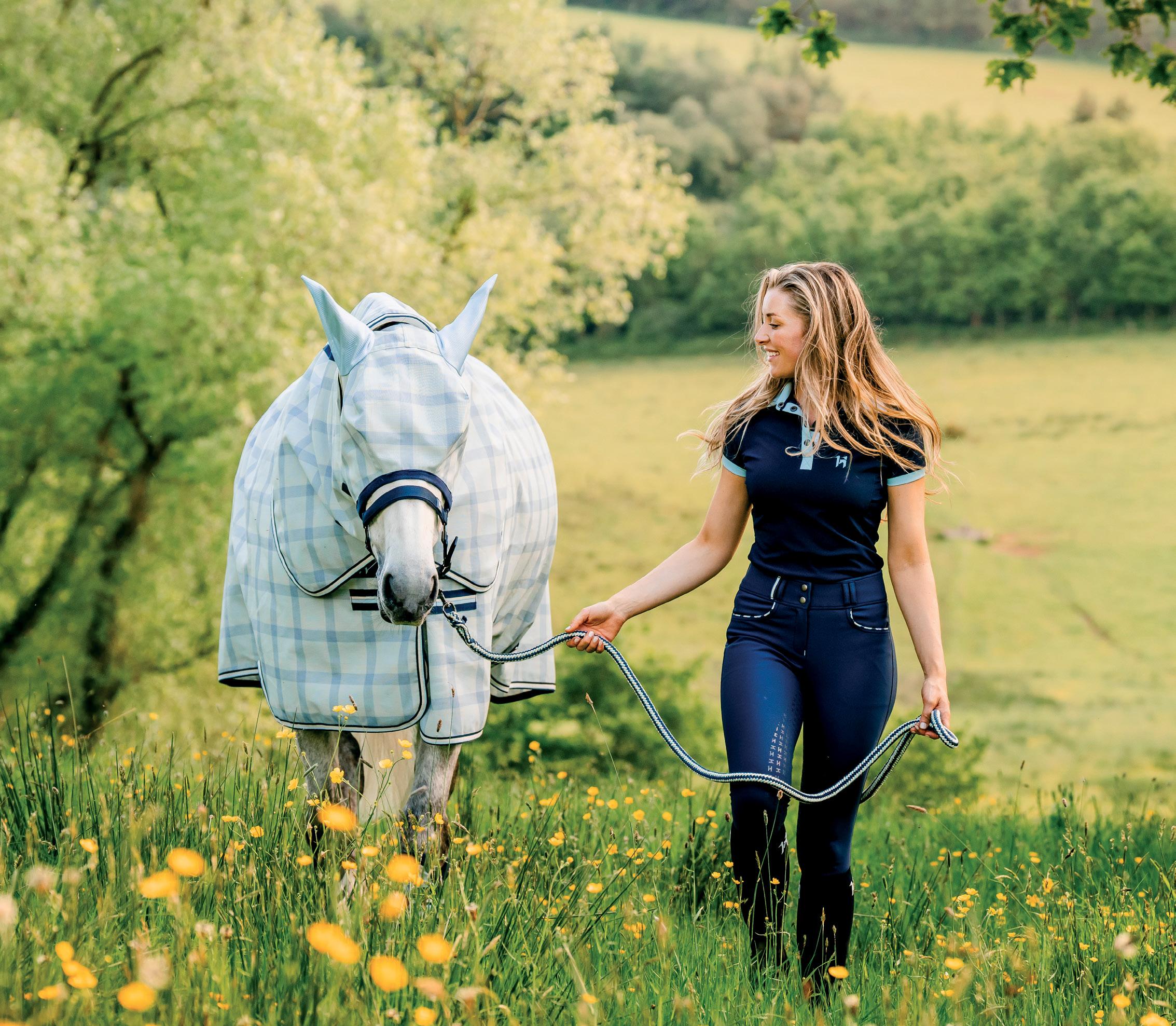

Designed for performance, comfort and style, our new clothing collection features jackets, T-shirts, breeches, riding tights, coats, and socks, crafted from high-quality technical fabrics for durability and flexibility. Our clothing is thoughtfully designed to complement our blankets, so you and your horse can step out in coordinated style. Whether training or at the barn, our apparel ensures you look and feel your best in and out of the saddle.
The National Breeds & Non-FEI Disciplines department celebrates the differences across equestrian sport — whether by region, discipline, or breed. From saddle seat equitation with a Morgan or roadsters with a Hackney, to carriage pleasure driving with a Shetland, this department strives to highlight how many opportunities there are to get involved with horses.
“It is about celebrating differences across the sport in the various breeds and disciplines, and recognizing what makes everyone so unique,” McSweeney said. The department also acknowledges that we evolve as equestrians as we age. For example, a jumper or an eventer may take up a different discipline, such as Western dressage or endurance, later in life. “We are so passionate about the sport and our partnership with the horse. Without highlighting the differences within the sport, people are unaware of the opportunities out there,” McSweeney added.
According to Homer-Brown, the department is working diligently to demonstrate the various strengths of the affiliate breeds in new ways. “Some people have a discipline in mind, and they immediately migrate towards one breed,” she said. However, the department aims to highlight alternatives. For example, the Paso Fino Horse Association has a group of Paso Finos competing in trail classes. “When you think of a working Western-type horse like a Quarter Horse, or even an Arabian horse or a Morgan, you’re definitely not immediately considering a Paso,” Homer-Brown explained. “We’re trying to think outside the box and highlight these diverse breeds to show the versatility, uniqueness, and style that they bring to the table.”
Not only does being a USEF affiliate increase awareness, it also ensures that the needs and interests of that specific breed are known to the industry, and that rules, policies and initiatives that benefit the breed are created or modified. Overall, these benefits “make our breed more appealing to the general public, which should attract new exhibitors to the equestrian community,” explained Quackenbush, who described Hackneys as “the aristocrat of the show ring. They are very athletic, very versatile, and extremely intelligent.”
Ultimately, the work of the National Breeds & Non-FEI Disciplines Sport Department is dedicated to enhancing the experience of US Equestrian members involved in these sports, serving as the central hub for recognized affiliates and their members. By supporting affiliates, clarifying rules, assisting with communications, and helping to ensure well-run competitions and educational opportunities, the department creates a positive and accessible environment for members to pursue their passion for equestrian sport with their chosen breed or in their preferred discipline. Their efforts contribute to the health, vibrance, and growth of the equestrian community.
Learn more about the National Breeds and Non-FEI Disciplines by visiting usef.org/learning-center/introductionbreeds-disciplines








Utilize the latest technology with T3 Matrix Saddle Pads for maximum comfort and freedom of moment

by Debbie Elliot
The 2025 International Safe Sport Day is on August 8, and the theme for this year is “the people who make sport safe.”
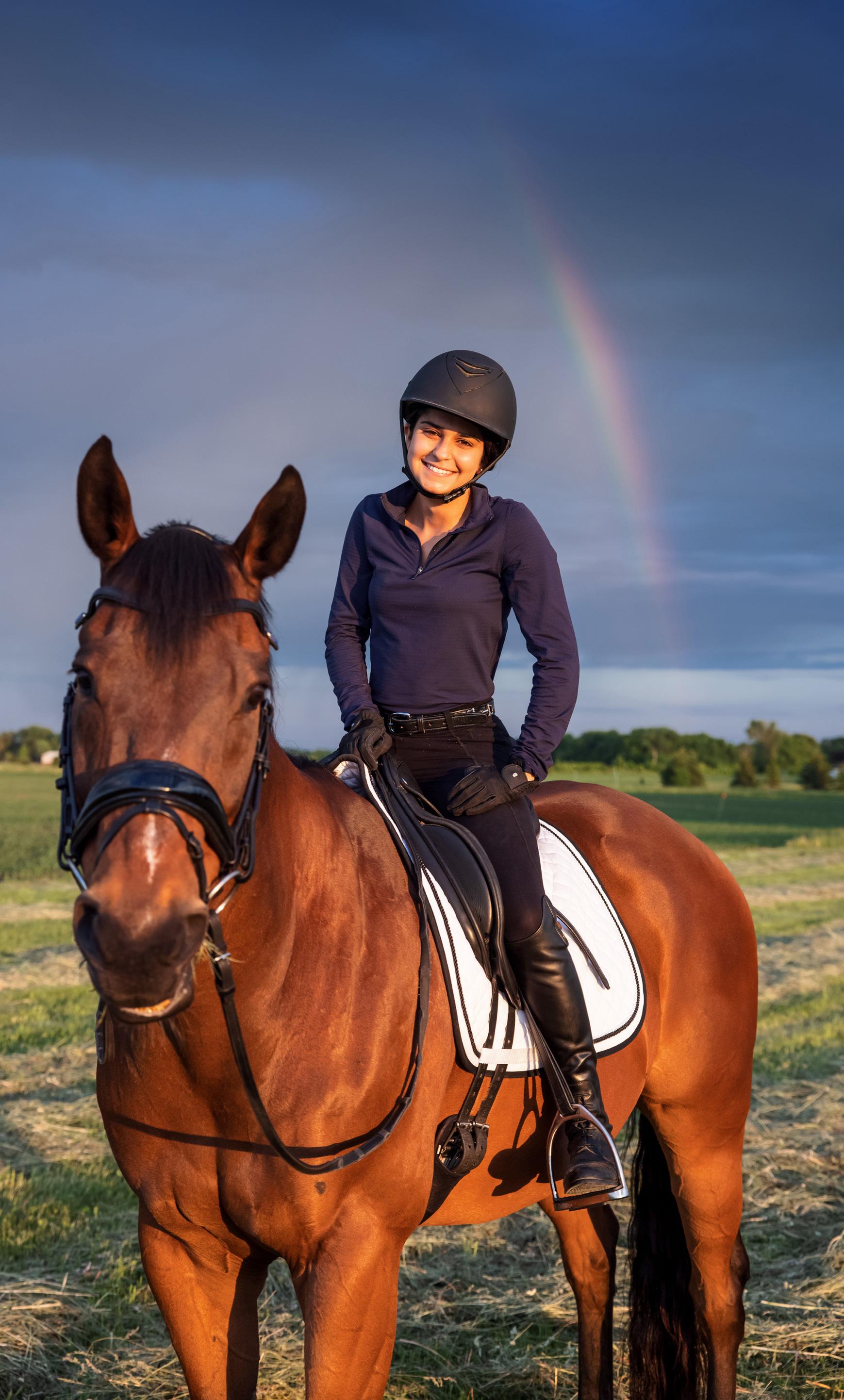
International Safe Sport Day encourages organizations from around the world to spotlight the importance of safeguarding children in sport.
August 8 marks 2025 International Safe Sport Day, when organizations around the world spotlight the importance of safeguarding children in sport. The day was established in 2020 with the goal of representing abuse and misconduct-free environments for all athletes. It was launched because the International Safeguards for Children in Sport Initiative wanted to celebrate the progress sports organizations were making in creating safer sporting environments for children, and also to encourage new organizations to start their own safeguarding in sport journey.
The International Safeguards for Children in Sport Initiative is comprised of over 140 organizations across six continents and aims to create a holistic approach to ensuring children’s safety and protection in all sports contexts internationally. The goal of Safe Sport International (SSI) is to have every individual, regardless of background or circumstance, to be able to participate in sport without fear of violence, harassment, abuse, or harm. SSI uses its global platform to empower athletes to know their rights, and acts as an ally to anyone who has ever been a victim. Knowledge, resources, expert insight, and personal stories can be shared across nations to empower athletes to champion safe sport in their own communities. SSI drives standards that focus on the SSI International Safe Sport Principles, the International Safeguards for Children and Adults in Sport, and the development of best practices in new areas for safeguarding in sport. It also uses evidence-based sports safeguarding knowledge to educate and advance national, regional, and international sports organizations. The theme for this year’s International Safe Sports Day is celebrating the people who make sport safe. It takes place on the eighth day of the eighth month to signify the eight international safeguards.
SSI encourages youth sports organizations to Take the Pledge by agreeing to the following statement and confirming that the organization has a safeguarding policy:
“We are committed to working towards safe sport for every child. We pledge to promote the Safeguards through our networks, embed the Safeguards in our work, and support Safe Sport Day.” Individuals and organizations can share the #SafeSportDay2025 and #TakethePledge across their social channels as part of their commitment to making sport safe for every child. Last year, 50 countries were represented in the campaign.


USEF has extensive resources to educate our members, families, trainers, and all equestrians about what is safe, appropriate, and welcome within our sport.
In the United States, the U.S. Center for SafeSport is tasked with preventing, recognizing, and responding to abuse and misconduct within Olympic and Paralympic sport. As a proud member of the U.S. Olympic and Paralympic Movement, USEF seeks to educate our members, families, trainers, and all equestrians about what is safe, appropriate, and welcome within our sport.
Use the following resources to better equip yourself, your family, and your community as we recognize the collective importance of International Safe Sport Day.
The MAAPP is a collection of proactive prevention and training policies to help create a safer and healthier environment in which minor athletes can thrive. The MAAPP includes prevention policies for electronic communications, transportation, lodging, meetings, individual training sessions, manual therapy and therapeutic/recovery modalities, and locker rooms and changing areas. In December 2024, the U.S. Center for SafeSport made revisions to their MAAPP, which the US Equestrian Federation mirrored in their most recent iteration. These revisions included updates to the following:
• Electronic Communication Policy
• Transportation Policy
• Lodging Arrangements
• Residential Environment
• Billeting
• Meetings & Training Sessions Policy
• Manual Therapy, and Therapeutic and Recovery Modalities
• Close in Age Exception
• SafeSport Training Exemptions
For full details on the MAAPP including the latest revisions, please visit usef.org/maapp. For reporting MAAPP violations go to usef.org/safe-sport/reporting
SafeSport training is required for USEF members (18 years of age or older) and is essential in creating a safer environment for our competitors. Regardless of whether your engagement with equestrian sport brings you into everyday contact with young participants or not, SafeSport Training is required. SafeSport Training gives all of us the knowledge to be part of the solution to keep our young people and our sport safe. The online SafeSport Core course lasts approximately 60 minutes and needs to be completed every four years. In the intervening years, 30-minute refresher courses must be completed annually. There are also individualized training sessions for coaches, parents, or kids (age five to 12) and youth athletes (age 13 to 17).
The U.S. Center for SafeSport offers additional MAAPP training opportunities for those wanting to learn more. They are scheduled throughout the year with options for live in-person training, virtual training via Zoom, or on-demand recordings, which can be found at maapp.uscenterforsafesport.org/trainings.
USEF has developed resources to help members and athletes to understand, and comply with the U.S. Center for SafeSport Code, the USEF Safe Sport Policy, and MAAPP policies. This includes MAAPP Awareness posters in both English and Spanish, and Safe Sport Awareness & Resources posters in English and Spanish, and sample consent language for parents and trainers.
USEF offers confidential counseling for members to aid with mental health issues. US Equestrian members are eligible for three sessions with a licensed provider. Counselors are available 24/7 by calling 1-800-633-3353. McLaughlin Young, a specialist in offering mental health services to non-profit organizations, provides this service.
There are actions you can take if you suspect a Safe Sport violation or have a reasonable suspicion of sexual misconduct such as child sex abuse, non-consensual sexual conduct, sexual harassment, or intimate relationships involving an imbalance of power. It is a legal requirement to report sexual misconduct involving a minor to the authorities and to the U.S. Center for SafeSport (call 833-5US-SAFE). USEF handles all reports of non-sexual misconduct, including harassment, hazing, bullying, physical, or emotional misconduct or a violation of the Minor Athlete Abuse Prevention Policies. Non-sexual misconduct may be reported to USEF, anonymously and at no cost, by submitting an Incident Report Form at members.usef.org/reporting-forms/ safe-sport-incident, or by e-mailing/calling a representative on the Athlete Protection Team. Contact details can be found at usef.org/safe-sport/reporting. You can also text or WhatsApp an anonymous report via RealResponse to 2USEF (28733).
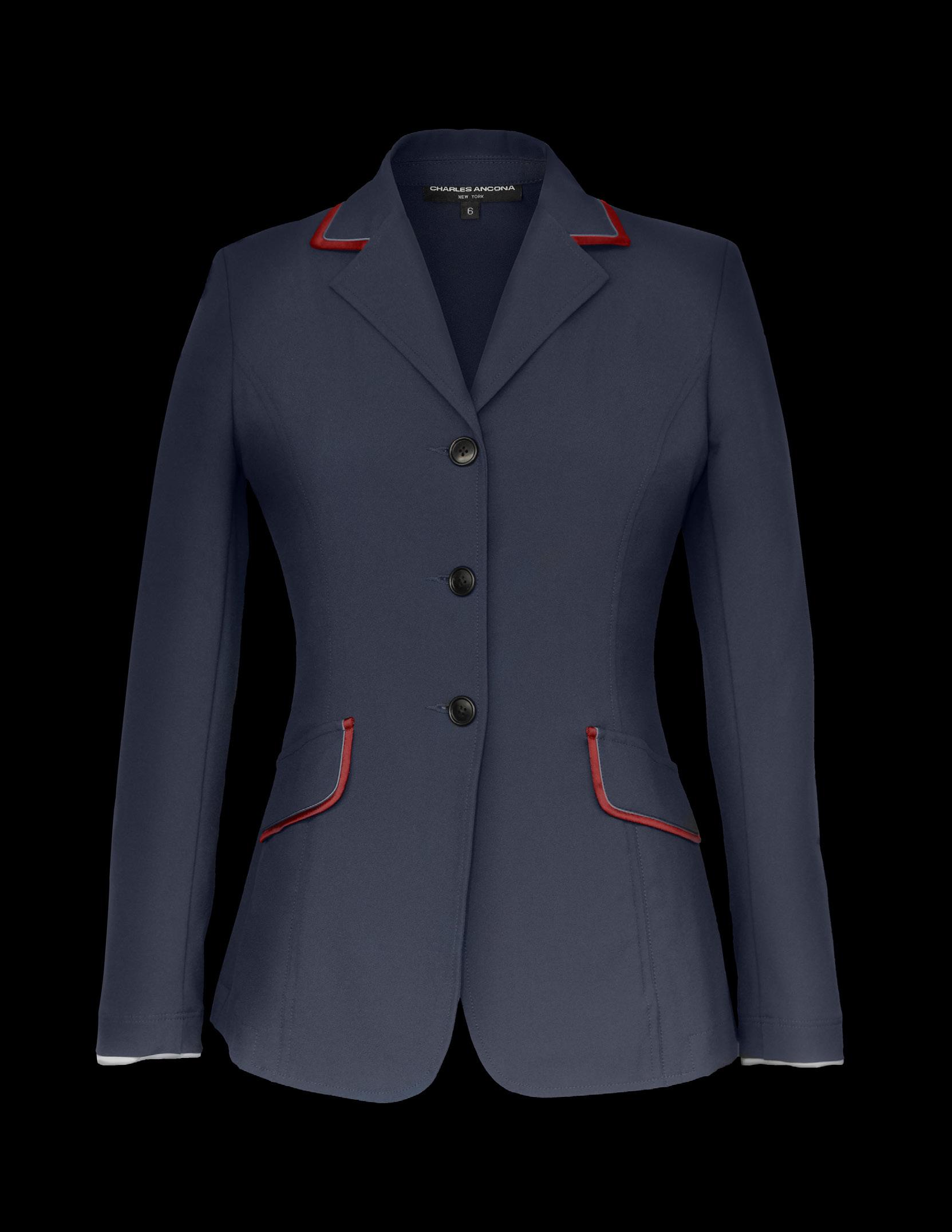
NEW YORK
CUSTOM FIT & DESIGN





There are 70,000 wildfires each year in the U.S., and horse properties in rural areas with dry vegetation are particularly at risk.
BY DEBBIE ELLIOT

When Sharon Gray of Pasadena, Calif., saw flames in the canyon above her property at 6:20 p.m. on January 7, 2025, amid blustering 80 m.p.h. winds, she knew she had to evacuate her entire barn — and quickly. The owner of Eaton Dam Stables had literally 20 minutes from when she first became aware of what would become one of Los Angeles’ most destructive wildfires in history to coordinate getting all 39 horses to safety. “There was the fire above us, and the wind blowing directly in our faces. We knew that we had to leave,” Gray said. “I just turned around and started barking orders. I told everyone to get the horses out of the barn, because it was made of plywood, and into the corrals.” Most of the horses were wearing blankets and fly masks to protect them from debris flying in the hurricane-level winds, but they immediately came off as they can easily catch fire.
“Luckily, we are situated within a flood control dam and the county had recently stripped all the vegetation around us, so there was not a lot near the barn to burn,” Gray explained. “I knew we had a safe spot down at the bottom because there’s a big flat staging area, so we gathered everyone there.” She said that a major issue was flammable palm tree fronds, which turned into “flying, burning missiles” that set anything alight in their path.
The next challenge was to figure out where they were going. Gray stressed that you should always know where your evacuation zones are, but with both the Eaton Fire and the Palisades Fire spreading so fast, she wasn’t sure at first what the best option was, as it “felt like the world was on fire.”
She quickly found out that the Los Angeles Equestrian Center (LAEC) was accepting equine evacuees, and they took the first load of horses there. When they unloaded, she noticed a burning smell in the trailers and realized that embers had sparked the shavings. “When you are hauling horses in a fire, you shouldn’t have shavings in the trailer, but we did not have time to clear them out,” she said.
Jennie Nevin, executive director of business development and communications at LAEC, said staff at the equestrian center were on high alert in the days leading up to the fires because of the intense winds. In the first 12 to 24 hours of the fires, they had up to 300 animals arriving there, with sheep, donkeys, pigs, and goats evacuating along with horses. Local volunteers set up a command center, and Animal Services arrived on site once LAEC was designated as an official evacuation center by the office of Emergency Services and the L.A. Fire Department. “This was definitely the largest evacuation we’ve had due to the unprecedented scale of the fires, the impacted areas, and the number of properties under threat,” Nevin said. “We became a refuge, a safe place, and a calm in the storm.” Horses and large animals were housed in the show stalls, and evacuees and volunteers caring for the animals were able to use the Equidome arena, show arenas, sun pens and turnouts for exercise.
Meanwhile, at Eaton Dam Stables, “a cavalry of volunteers showed up at the barn with trailers,” Gray said. Some were boarders, others were people who had been alerted via Facebook, all were willing to risk their own safety to help. “They were waiting for the firefighters to escort them in because everything was burning,” Gray recalled. “It was insane how fast it spread. It was such a wind-driven fire, and the firefighters just couldn’t keep ahead of it.” Some members of the L.A. County Sheriff’s Department started turning horses loose, and they were captured in iconic local news footage cantering down a road surrounded by flames. Releasing horses — especially in an urban area — is a last resort, but if you must do it then you should always close stall doors afterwards, otherwise “they’ll go back to their safe spot, which is their stall. That is how horses die,” Gray warned.

• Train your horse to load into ramped or step-up trailers of various sizes, and ensure you have access to transportation.
• Have a tag with your name and number on your horse’s halter. In rural areas where a head collar can get snagged on a branch, braid a luggage tag into their mane or tail. An ID bracelet can also be placed around their hind pastern.
• Use a leather halter as nylon can melt and cause burns.
• Plan multiple evacuation routes from your barn in case roads or pathways are blocked.
• Familiarize yourself with local evacuation centers and create a network of nearby horse owners ready to help each other in a crisis.
• Have an emergency three-day supply of water and feed available.
• Practice evacuation drills (in daylight and at nighttime) and know what order horses should be loaded in order to keep them calm.
• Install reflective tape along exit paths from the barn to guide rescuers during low visibility or nighttime emergencies.
• Barns should be fitted with smoke alarms and have fire extinguishers at strategic places, plus reliable water access via hoses.
• Use standardized/universal stall latches that can easily be opened by first responders.
• Create a secure outdoor area where you can put your horses during a fire.
• Avoid storing hay, shavings, or other flammable materials in the barn where horses are housed.
• Local fire departments will often be willing to do a property tour to offer advice on disaster preparedness and to identify risks. This will also familiarize them with the barn location and layout if they have to respond to an emergency.
• Download the free Watch Duty app, which tells you what fires are active in your area, provides live updates, and information on road closures and evacuation zones.

Sonja Larsen-Schmutz, who boards her Thoroughbred and Mustang at Eaton Dam Stables, couldn’t tow a trailer with her Honda Fit, so she focused on setting up stalls at LAEC. “Getting horses settled, giving them water, shavings, hay, and seeing who needed calming paste because they were all just completely freaked out,” she said. Larsen-Schmutz recommends giving each person at the barn a specific role in advance, so that everyone knows how best to help when there is an emergency. For example, she took photos of the horses from their barn at LAEC with their stall numbers and posted them on their Facebook page so people could see their horse was safe. “Other people were getting the horses out of the fire, and I didn’t need to be at the barn getting in the way. There’s only so much people can do during the actual evacuation,” she said.
Gray and her team managed to get all the horses safely to LAEC, aside from two minis who were taken by a Good Samaritan in his trailer to a nearby neighborhood. But then Gray had a horrific revelation. “We were missing Claire,” she said, referring to her client’s beloved Gypsy Vanner mare. “That was terrifying.” Following a night of frantically trying to find her, a client of Gray’s who worked for Animal Control and could access the closed-off fire areas brought great news. Claire had been found wandering at the barn, wondering where all her friends had gone. “She had some burns around her mouth, singeing to her mane, feathers, and under her belly so we had the vet check her out, but aside from that, she was fine,” Gray said.
Gray, who had experienced a prior wildfire 30 years earlier, said she was calm in the moment and did what needed to be done, but “fell apart later.” When she went back to the property the next day to inspect the devastation, she saw that both the barn and the trailer that she lived in were gone. “That’s when the tears came,” she said, as she realized they were all staying at LAEC for a while and began to anticipate the hard road ahead. “The emotional side of dealing with it is not fun. I just had to stay strong and let everyone know it was going to be OK.”
Gray and the Eaton Dam Stables boarders were blown away by the community support. “I cannot believe what the horse world does for the horse world,” Gray said. Nevin agreed, saying: “In times of crisis, we’ve found that people in L.A. really come together as a community ... we had as many as 100 volunteers at a time pouring in to help or bringing supplies.”
After four months at LAEC, the horses were finally able to return to Eaton Dam Stables in mid-May. “Although there is still a lot of work to be done, we are happy to be home!” Gray

said. The burned barn has been removed, and she has plans to build turnout pens where it once stood and to enlarge the arena. With the help of GoFundMe donors and Fleet of Angels, she was also able to purchase a mare motel.
Both Gray and LAEC worked closely with national nonprofit agency Fleet of Angels, which provided food and supplies for evacuated horses. “Covering the cost of caring for horses in a crisis can be a challenge, so we try to keep the affected horses safe and fed until their owners find other solutions,” said Fleet of Angels founder and executive director, Elaine Nash.
Following a natural disaster like a wildfire or hurricane, Nash and her team raise funds, gather local resources, and rally volunteers to administer their disaster response efforts on the ground. “No one has equine evacuation centers full of supplies ready to go,” she explained. And with the LA fires, “the need was on such a huge scale.”
“We are pretty good at being first in the door with the feed and supplies that are needed,” she continued, so Fleet of Angels quickly started stocking the LAEC and Pierce College in Woodland Hills, Calif. (another major evacuation location) with essentials such as hay, wheelbarrows, buckets, hoses, rakes, etc. “These are things you don’t think about in a crisis when you’re trying to evacuate your horse,” Nash said. With a total of 408 horses evacuated to LAEC and over 200 at Pierce College, the demand for essentials was enormous. “We were able to purchase everything locally, which we always try to do, as we like to keep the money circulating in the community,” said Nash, adding that local feedstores often offer a discount for nonprofits. “Endeavors like this are extremely expensive. We keep our internal operations costs very low, and we try to get everything we can donated.”
Fleet of Angels also provided nebulizers donated by Flexineb for horses suffering from smoke and ash inhalation, and distributed airway supplement products donated by SmartPak. “We try to be the Grand Central Station for anyone who wants to help with products or donate funds but don’t know where to send them,” Nash said, and on the flip side, they are the organization that equestrians in need turn to for help. People can also apply as an individual or as a rescue for grants to help fund their recovery, such as receiving assistance with barn supplies, fence repair materials, and vet care. “Our policy is that we exist to help horses in crisis,” Nash said.

On January 7, while Gray was watching the Eaton Fire rapidly approach her barn, Mel Sobolewski mobilized her animal emergency response team to respond to the Palisades Fire by ensuring trailers and trucks were loaded with essential gear, and all electronics fully charged. “We coordinated with stable owners on critical preparedness steps: relocating horses from pastures and barns to easily accessible areas for quick loading, removing hay from trailers to prevent ignition from flying embers, securing important documents like veterinary records, and identifying evacuation destinations,” she said. “At one point, there were five fires at once and it felt like the whole city was going up in flames.”
Sobolewski — who has certifications in fire rescue, first aid, and FEMA training — explained that many first responders are not trained to handle large animals, and her grassroots group often arrives on the scene even before the firefighters. “You are going into a war zone. It is essential to know fire patterns and fire safety, but also traits like how a donkey kicks and where a horse’s blind spots are,” said Sobolewski, who adopted her horse, Hickory, after the Woosley Fire in 2018.
“When a barn is on fire, you typically have only three to seven minutes to get your animals out before it’s too late, which is why preparation is absolutely critical,” Sobolewski said, adding that horses in pastures or corrals have a higher chance of survival than those in stalls. She also stressed the importance of sufficient transportation, because with fast-moving fires, there often isn’t time to make return trips to pick up extra horses.
During the L.A. fires, Sobolewski used her Instagram account as a beacon of information for those in peril. “I shared my phone number and maintained constant availability, posting real-time updates about evacuations, rescues, and resource availability and needs,” she said. The community response was outstanding, her team could quickly match trailers with animals needing evacuation and send volunteers to impacted areas. “I witnessed civilians guiding strangers down mountain paths with fire raging on both sides,” she marveled. “Community members loading their personal vehicles with people they’d never met, driving them away from advancing flames without hesitation. People helping walk horses out of harm’s way or even riding them down a mountain ... These were everyday people making split-second decisions to help others that made the difference between life and death for both people and animals, they were ordinary individuals performing extraordinary acts when it matters most.”

While tags, halters, neckbands, and bracelets can come off, and tattoos and brands can be altered, a microchip is a permanent identifier for your horse that cannot be changed. “Implanting a microchip is a significant benefit for retrieving a horse after a natural disaster such as a wildfire,” said Dr. Katie Flynn, senior veterinarian of Equine Health and Biosecurity at US Equestrian. “Any temporary identification can all be accidentally or deliberately removed, or become no longer visible, and even a horse’s identifying marks can be damaged during a wildfire,” she added. If a horse is microchipped, vets at evacuation centers can scan it and access the owner’s personal information. At LAEC during the Los Angeles fires, “the microchip option was amazing because officials and vets were able to look for them with a scanner and reunite horses with owners,” Nevin said.
Flynn recommends a Bio-Thermo microchip that also allows you to monitor your horse’s health after a natural disaster by giving their temperature.
As of Dec. 1, 2025, any horse that enters a USEF-licensed or -endorsed competition, regardless of breed discipline or level of competition, must have an ISO compliant 15-digit microchip.
Sobolewski’s team is also trained in CPR and basic human life support, as they encounter people in need while rescuing animals. During the Palisades Fire, they had to flush one child’s eye out and performed triage on an owner who was hit with flying debris.
Former hunter/jumper rider Ami Cullen got first-hand experience of a large-scale equine evacuation in October 2020 when a massive wildfire threatened the 8,500-acre C Lazy U Ranch in Granby, Colo., where she is the Director of Equestrian Operations.
Having grown up in the Philadelphia area, “I had zero experience with wildfires,” said Cullen. She first noticed an issue with smoke when some of the 220 horses at the ranch had watery eyes, and were coughing and sneezing, so they moved the most vulnerable animals to their vet’s property. “I learned very quickly that one of the rules of fire country is when you get a pre-evacuation order — you go, no matter what,” said Cullen, who has since published the book Running Free, based on her experiences. Once the official order came through, they moved the entire herd to a neighboring ranch 10 miles away, but tornado-level winds soon put that property in peril. “The winds were so strong they were practically knocking me over ... you could see flames coming over the ridge. It was pure chaos and felt like a Hollywood movie,” she recalled. “The fire was so strong that it formed a pyro cumulus cloud, and essentially created its own weather system.”
As all their neighbors now also needed to evacuate, Cullen and her team of wranglers went on social media and posted a public cry for help. “People came from all over Colorado with trucks and trailers to move the horses,” she said. “I realized you can be as prepared as you want, but in those moments, you have to rely on other people to help. You need extra hands, you need extra trailers. We had every type of trailer brought, from a luxury polo rig from Aspen all the way to cattle trailers,” she
said. The ranch was home to Belgian drafts and Clydesdales that couldn’t fit in regular trailers, but luckily someone came with a semi-truck and transported them. “Another thing that I didn’t even think about until that moment was that we didn’t have enough halters for all the horses, as we never halter all 220 of them at the same time,” Cullen revealed.
Fortunately for the second evacuation, they were able to traverse a giant mountain pass and take all the horses to a facility in Evergreen, Colo., that had a pasture big enough for the whole herd. To make matters harder, “When some of the trailers crested the pass to get there, they drove into a full winter ice storm!” she marveled. “Some of the trailers were jack-knifing on black ice.”
Cullen’s staff did their best to put horses on trailers with their friend groups, as they understood the herd dynamics and personal attachments. “Once they were all safe in the same pasture, the stress level was non-existent,” she said. The herd stayed there for two weeks, then another group of volunteers was utilized to take them home once the fire was extinguished.
In hindsight, Cullen advises having a printed plan displayed at the barn that includes contacts for evacuation options and social media resources, “You need a plan A, but also a plan B and C,” she added, as fires are notoriously unpredictable. She also warned that propane tanks should always be turned off in case of a wildfire, then inspected by a professional before turning back on.
While wildfires are certainly terrifying and extremely dan gerous, they don’t have to be deadly. As Sobolewski concluded, “Timing is everything in evacuations. Our preparation in those critical early hours made all the difference when the Palisades and Eaton fires escalated.”
The January 2025 wildfires in Los Angeles burned over 57,000 acres, killed 30 people, and destroyed 18,000 homes. Our deepest sympathy goes out to all those impacted.























“It Was Like

When 14-year-old Ryan Haselden suffered a sudden cardiac arrest in the middle of her 1.20m class, disaster was averted with fast action and a life-saving AED.
BY DEBBIE ELLIOT
In the middle of her 1.20m course on her 14th birthday while competing at Fox Lea Farms in Venice, Fla., Ryan Haselden suddenly stopped responding to her horse, Hector Du Gue, and allowed him to veer awkwardly past Fence 4. As the gelding reached the other side of the ring and stopped at the rail, the accomplished teen rider slumped in her saddle and slid off, hitting the ground limply. “She had been upright, she was there, but nobody was home,” said Ryan’s dad, Will Haselden, who was watching from the stands. “She put up no defenses. She just went down ... it was just like how a bag of grain would fall off the side of a saddle.”
While everyone in the grandstand — including her parents — initially thought that Ryan had fallen off, she had actually suffered a sudden cardiac arrest and collapsed mid-round. Even after she came off, Will and his wife, Lindsay (who was on her own horse outside the ring when it happened), hesitated before running into the arena because “watching kids grow up riding, they’ve fallen off plenty of times. It’s the nature of the sport,” Will said. But when Ryan didn’t move, it quickly became clear that something was seriously wrong.
Miraculously, physician and amateur jumper Dr. Karley Koch, of Tulsa, Okla., was showing at Fox Lea and was sitting in the stands waiting for her friend to ride. When Ryan’s horse, Hector, first went off track, Dr. Koch thought she had
forgotten her course or was trying a weird inside turn. But then she realized Ryan had stopped riding. “By the way she fell, I immediately knew something was wrong,” Dr. Koch said. “I don’t usually like to gallantly run into a ring when someone falls off and declare myself a medical professional, that’s why shows have EMTs,” she said, but having witnessed Ryan’s strange behavior and now seeing she wasn’t moving at all, Dr. Koch knew she needed to assess the situation. The show’s EMT, Katy McPhee, also rushed in to help. “Ryan was cyanotic, which means her lips and face are turning blue, and she was agonal breathing,” which are end-of-life gasps that occur when death is imminent. Dr. Koch checked for a pulse, when none was found and after making a full assessment of the scene, she told McPhee that they should start compressions.
With events unfolding so rapidly, Will was still in shock. “There’s no part of you that thinks this is where it ends ... I thought, ‘Of course she’s going to be OK,’” he said. “She had never had any kind of heart problems or any signs in her medical history to suggest this might happen. At that point, we still thought it was from the fall.” Will, who is CPR-trained, was prepared to step in to help with compressions, but was “very thankful that my turn never came,” as that would have been even more emotionally traumatizing. As Will has since learned, if you suffer a sudden cardiac arrest outside of a hospital setting, your odds of survival are about 10 percent, “which is a horrific statistic,” he said.
Dr. Mark Hart, a cardiologist and the USEF Human and Equine Safety & Welfare Committee Chair, said that sudden cardiac arrest is “relatively

“BY THE WAY SHE FELL, I IMMEDIATELY KNEW SOMETHING WAS WRONG.”
rare” in young people, and in Ryan’s case, there was no way of knowing ahead of time that she was at risk. “The important thing is that if it does happen, you evaluate the patient to see if they are breathing and if they have a pulse (the easiest place to check is the carotid artery, located on each side of the neck),” he explained. “If there is no pulse, then you need to initiate lifesaving techniques, with an AED (Automated External Defibrillator) and/or by starting CPR until the AED or emergency services arrives.” The longer it takes to get the heart rhythm back to normal, the higher the risk of significant brain damage, neurological symptoms or death.
Dr. Koch was well aware of the urgency of the situation unfolding at Fox Lea. “Every second that you’re not getting blood circulation is seconds of no oxygen, and your body only has a few minutes of reserve in which you can intervene before it’s too late,” she explained. “As healthcare workers, we go into algorithm mode: we follow what we’re supposed to do in the moment, it just became rhythmic. There’s no panic and there’s no freaking out.” Dr. Koch is no stranger to handling medical emergencies. “I’m a hospitalist, which means if you go to an ER and you’re so sick that the doctor doesn’t think that you can go home safely and you need inpatient hospital care, then I am the doctor they will admit you to,” she said, explaining that part of her job is running codes in end-of-life situations.
As Dr. Koch and McPhee continued CPR, they gave instructions for someone to call 911, and to bring an AED. Once it arrived, they put the pads on Ryan’s chest, and it immediately identified a shockable rhythm. “We cleared the area and let it shock her, and then resumed CPR,” at which point Ryan let out a gasp, coughed and regained consciousness. Once they confirmed that she had a pulse again, Dr. Koch and McPhee moved into a secondary assessment, stabilizing her cervical spine and neck. “Even though that did not contribute as to why
she fell off, she still fell off her horse and hadn’t been conscious to tell us if something hurt,” she explained. They then asked orientation questions such as “Who are you? Where are you? What year is it?”
“It was very scary for Ryan at that time because she didn’t know what was going on,” Dr. Koch revealed. Ryan said she cried when she woke up and “had no idea what was happening — it took me a second to breathe. The last thing I remembered was thinking I had jumped the fourth jump, which I didn’t luckily, and then I woke up and there was a ton of people around me. It felt like seconds ... I went to sleep and then woke up and was in a different place,” she recalled. When it comes to the actual cardiac arrest, Ryan said, “I had no pain in my chest, absolutely nothing. It was like turning off a light switch.” Once she was breathing on her own again, Dr. Koch let Lindsay and Will comfort Ryan. “That’s when I really felt good about it. I thought ‘OK, we are out of the bad part.’”
“The fact that she came out of it as readily as she did and with no ongoing issues is an incredibly miraculous result,” Will said. “I think a lot of the feelings that we have experienced about the situation have come on much heavier after the fact as we’ve realized exactly what it was that we got away with. It hits you like a truck.”
The family has video of Ryan’s jumping round and subsequent fall, which ironically is not very dramatic to watch. “It shows you that this sort of event doesn’t always look like fireworks going off. It happens very quietly,” Will said. “When you see it in the movies, someone’s always clutching their chest and knocking things over — that’s not how things happen. You’d almost call it a fainting spell. You’re there and then you’re not there.”
Ryan was airlifted by medics to Tampa General Hospital and then later transferred to Johns Hopkins All Children’s Hospital in St. Petersburg, Fla. Dr. Koch ensured that she passed
on her report to the accepting ER physician so they knew what had happened. She told Will that it was important that he told Ryan’s doctors that this was not a horse-riding accident, that she had blacked out while riding rather than simply suffering from a fall. “I knew something underlying was wrong, but I didn’t know what it was yet,” Dr. Koch said.
Ryan’s medical team subsequently diagnosed her with catecholaminergic polymorphic ventricular tachycardia, a rare heart rhythm disorder that is characterized by a fast, abnormal heart rhythm and can be triggered by exercise, stress, or strong emotions. She now has a defibrillator implanted into her chest to detect and correct life-threatening heart rhythm problems.
“CPVT is a genetic mutation that is sensitive to adrenaline,” Will explained. “When she’s doing something fast-paced and she gets that adrenaline spike and her heart rate goes up, it leads to an electrical malfunction in her heart.” The condition primarily affects young people, most often aged eight to 12.
“The defibrillator is a safety net,” he said. “It is not doing anything on a constant basis other than measuring her heart rhythm, but if something were to happen, it’s there and she would be saved before we even realized she needed an AED.” Ryan will also be on medication for the rest of her life to limit how high her heart rate can go.
Will is forever thankful that Dr. Koch was in the stands when Ryan suffered her cardiac arrest, because if she’d been anywhere else on the showgrounds, it would have increased the amount of time before someone noticed what was happening. Ryan was also fortunate that Fox Lea had an easily accessible AED in good working order. The average emergency services response time in the U.S. is seven minutes (even longer in rural areas), and every minute an AED is not used, a patient’s chance of survival goes down significantly. USEF strongly recommends AEDs at show grounds and for staff to undergo training, but it is not a requirement at all competitions. However, it is a requirement for Hunter competitions at all levels and Jumper competitions at Level 2 and above. The rules state that the AED must be operable and placed in a designated, safe location. All qualified medical
—
Dr. Mark Hart, USEF Human and Equine Safety & Welfare Committee Chair


personnel must be informed of the AED’s location prior to the start of competition. Based on their licensed ratings and levels, Fox Lea was required to have an AED.
The Haselden family is sharing Ryan’s story in the hope that more shows, barns, and non-equestrian sporting events will ensure that they have AEDs — and that the staff knows where they are located. “An AED is of no use if the batteries are dead, or it is locked up in a concession stand and nobody present has the key,” Will said. “If you’re required to have an EMT on site, make sure the EMT has an AED as part of their ring bag,” he advised. He would also like to see more trainers certified in CPR/AED, as they are often ringside and focused on their clients.
Dr. Hart said that AEDs are now commonplace in airports, malls, schools, and other public areas, as they are easier to use than performing CPR. “Some CPR is better than no CPR,” but it is exhausting to perform compressions for a prolonged time, even for medical professionals. “A lot of times, CPR doesn’t necessarily revive you, but it keeps the blood flow to the brain going until you’re revived or until the heart rhythm comes back,” he explained.
With an AED machine, “you don’t even need to know the rhythm. It’s smart enough that it will know when the heart needs a shock and will deliver it,” Dr. Hart said. “The instructions are so simple ... you can’t really do any harm to a patient because the machine makes the decision whether to shock or not. Basically, all you do is put on the pads where it tells you to, press the button and the machine talks you through the process.”
The Haseldens, of Alpharetta, Ga., have since hosted open CPR/AED classes in their community to encourage people to get certified. They are also in conversation with Georgia’s representatives to increase the accessibility of AEDs in youth sports. “This could have happened at any kind of youth sporting event where there’s physical activity,” Dr. Koch said. The incident, “has really opened my eyes, and I encourage everyone to get certified,” she continued. “Everything I did, you can learn in a basic non-healthcare worker, CPR and AED class. I don’t want people to look at Ryan’s situation and think, ‘she’s alive because there was a doctor there.’ I’d rather people say, ‘she’s alive because someone knew how to do CPR, and they had an AED.’” Once you’ve been trained, if you find yourself in an emergency situation, “Trust that the information is in there in your brain” and calmly follow the steps.
Dr. Hart concluded, “sudden cardiac arrest can happen at any age with no prior history of heart issues. However, you can save a life with no neurological consequences if CPR is carried out and an AED is available.”
Ryan, who owns three horses, was given the all clear by her doctors to ride again. “I feel pretty normal and am ready to get back to everything,” she said. Her fatigue and stress levels are being monitored to ease back into it carefully and safely. She returned to showing in May, three months after her sudden cardiac arrest, on her horse Nour Alain (Carla). Ryan also planned to return to Traverse City in July to compete in the FEI North American Youth Championships (NAYC) on Hector.

While sudden cardiac arrest is not nearly as common in horses as it is in humans, there have been cases of sudden cardiac death afflicting racehorses and eventers, and any horse in any discipline can potentially be affected. The symptoms of heart issues most often seen in horses are murmurs and arrhythmias, said Dr. Meg Sleeper, VMD, DACVIM, a Clinical Professor of Cardiology in Gainesville, Fla.
“What makes diagnosis challenging in horses is they can have benign murmurs, which do not affect heart function. However, it may be difficult to differentiate a benign murmur from a murmur associated with disease that negatively impacts the horse’s cardiac output, and diseases can worsen over time,” she warned. “A murmur should always be evaluated by a veterinarian, who can then determine whether it is likely to be benign or not. Sometimes it’s hard to tell without further testing,” she added.
A heart murmur can be detected by listening to the horse’s heart sounds with a stethoscope, however, “unless somebody actually listens to the heart, the owner wouldn’t necessarily know anything was wrong,” Dr. Sleeper explained. “Horses often don’t show any symptoms unless they’re actually decompensating [meaning that heart’s ability to pump blood to meet the body’s needs is significantly impaired] and approaching heart failure. If there is significant underlying disease, the horse may display poor performance and fatigue earlier than usual.”
The best prevention against heart issues is regular examinations by a vet, along with good nutrition to maintain healthy body condition. “Every horse should get at least one thorough physical exam per year,” Dr. Sleeper said. “If they’re not acting normally, if they seem to be tiring earlier or acting out of character, then you should immediately get a cardiac exam. It is a simple screening test that can identify potential problems before they become major problems. A cardiac exam is basically listening to the heart and assessing the cardiovascular system (such as pulse quality), so it is quick and doesn’t have to be expensive.”
Horses do not suffer from coronary disease the same way people do, but general good healthcare is still important, according to Dr. Sleeper.
“Parasite issues can cause cardiovascular damage to the blood vessels, so deworming is essential, as are vaccinations because if they develop certain viral infections, that can cause myocarditis (inflammation of the heart muscle).”
Arrhythmias, the broad term for any irregular heartbeats, also may indicate heart disease, and they too can be identified in a physical examination through auscultation with a stethoscope. “Arrhythmias can lead to sudden death, so abnormal heart rhythms should not be ignored,” Dr. Sleeper said.
For horses in atrial fibrillation (A-fib), a common heart rhythm disorder where the upper chambers of the heart beat rapidly and irregularly, the longer horses are left untreated, the harder it is to convert them back to sinus rhythm, Dr. Sleeper warned. To convert the horse’s heart rhythm to a normal, regular pattern, they can be treated with medication or shock treatment. “A-fib conversions are most commonly done with high performance horses, as many can’t compete successfully if they’re in atrial fibrillation because they need to have every bit of cardiac output to be successful,” Dr. Sleeper explained. “However, some horses that either cannot be successfully converted back to sinus rhythm (perhaps they have been in A-fib too long) or their job is not one that requires maximum cardiac output, can actually compete in atrial fibrillation.” In order to determine whether this is the case, an exercise test would be performed by your veterinarian. Thoroughbreds and Standardbreds are particularly predisposed to A-fib. “The bigger the heart is, the higher the risk,” Dr. Sleeper said.
Horses in congestive heart failure, a chronic condition where the heart can’t pump blood effectively leading to fluid buildup in the body, can often be treated with antiarrhythmics medications to keep them comfortable for many years, but they should no longer be ridden or worked, Dr. Sleeper said. If your horse is on heart medication and still competing, please refer to the USEF 2025 Equine Drugs and Medications Guidelines to check if the medication is allowed in competition.
•90% success in treating back pain and kissing spines
•Helps speed the healing of tendon and ligament injuries
•81% improvement in horses with Navicular Syndrome
•Clinically proven to reduce lameness associated with chronic orthopedic conditions

To find a veterinarian near you who offers PulseVet® shock wave therapy, visit Zomedica.com/PulseVet
To learn more, call or click Zomedica.com • 800.245.4417 info@zomedica.com




Zen Elite Equestrian Center, located in Southwest Ranches, Florida is everything the name suggests and much more.
The state-of-the-art facility hosts a spacious covered arena, two huge outdoor arenas and a full rehab/spa.
From the cascading waterfalls in the rider’s lounge, to its peaceful statues and inviting gardens, Zen Elite Equestrian Center envelops visitors in a spa-like relaxed atmosphere.
But Zen Elite is more than just soothing to the soul. The facility is unique in its scope, hosting grassroots dressage and jumping lesson programs in the same arenas where international trainers are preparing for national and world competitions.
Owner, Heidi Humphries’ vision is legendary, in that it supports the future of horse sport in the spa-like serene atmosphere that is Zen Elite Equestrian Center.

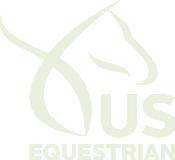


From Mustangs who compete in eventing to a spotted Pony of the Americas who excels in dressage, these horses are breaking the mold.
BY HELEN TOWNES





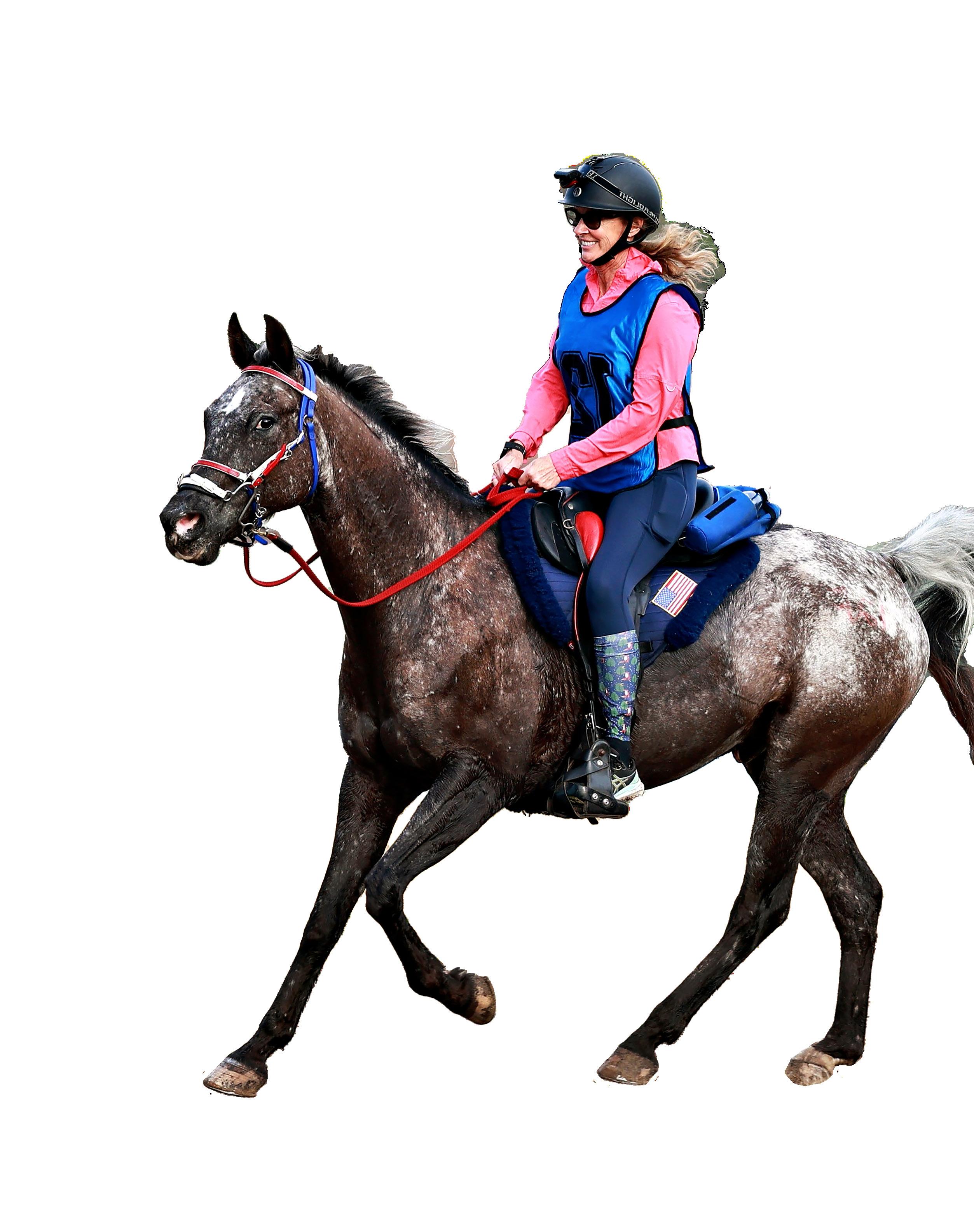



Equestrian sport is deeply rooted in tradition, especially at the higher levels of competition. Warmblood breeds are favored for dressage and jumping; eventing is often crowded with Thoroughbreds or Irish Sport Horses; and Quarter Horses and Arabians dominate Western disciplines like reining or endurance.
However, equestrian culture is evolving. While common stereotypes dictate that particular breeds excel in specific disciplines, there are numerous examples of horses outside the expected molds who are excelling in competition at the higher levels.
There are many reasons riders might pick unconventional breeds. Sometimes it is due to financial concerns, or a buyer might come across an exceptional horse that has the talent and temperament to succeed outside of their traditional role. Some riders have a particular attachment to a breed and are determined to make headway no matter what “tradition” dictates. For many equestrians, it’s a combination of all these factors.
Off-the-track Thoroughbred MVP “Captain” ran just two races at Oaklawn Park, in Hot Springs, Ark. — and he lost both.
“He was pretty scopey and could jump big jumps,” professional eventer Elisa Wallace said of her Mustang, Wyeth.
Opposite: Jennifer Melcher’s son, Nate, and Ziggy at the GDCTA Spring Fling, Alpharetta, Ga., in April 2025.
When amateur hunter rider Tess Fortune, of Louisville, Ky., saw his for-sale flyer from Illinois horse adoption agency, Galloping Out, she decided to go look at him with a friend.
Since childhood, Fortune had ridden mostly warmbloods, the more typical breed for the hunter ring, in her successful Junior and Adult Amateur show careers. Then her loyal show companion, a warmblood gelding named Epic, sustained a career-ending injury. Fortune had limited funds at the time, and the $2,500 adoption fee for Captain fit her budget.
“He was a narrow, smaller-framed, cribbing chestnut gelding, but when we got him out of the stall his movement immediately overshadowed his less desirable traits,” Fortune said. “I could see the slowness that held him back on the racetrack might make him the perfect hunter. In fact, my friend who came along said that if I didn’t buy him, then she would!” she laughed.
It proved to be $2,500 well spent. Since 2015, Fortune and Captain have twice won the Take2 Hunter and Jumper Finals at the Kentucky Horse Park in Lexington, Ky. They have ribboned several times in the 3’6” Amateur Hunters against top horses at elite shows including the National Horse Show, also in Lexington, and the Pennsylvania National Horse Show in Harrisburg, PA. Fortune and Captain have even dabbled in
international derbies, earning ribbons when competing against much more expensive horses.
Endurance rider Niki Beck, of Gillette, Wyo., grew up on the West Coast and always loved horses “but could never really afford them,” she said. Years later when Beck was married and working as a nurse, her OB/GYN husband accepted a job in Wyoming. “I said that I would only move to Wyoming if I could get a horse!” she said. Beck soon became interested in endurance riding and started competing in 25-to 100-mile races.
Along came Majestic Cloudy Boy (a.k.a. Cloudy) an Appaloosa/Quarter Horse/Arabian cross, who is registered as an Appaloosa because of his markings. Cloudy had been ridden in endurance competitions but was an unlikely competitive candidate for the higher levels of the sport, which is mostly dominated by Arabians.
“I was at a race and saw him with his previous owner, and I approached her after and asked, ‘would you sell that horse?’ I hadn’t even ridden him or looked at his race record. I just knew that I wanted that horse,” Beck recalled. “He has a very human expression. He just stares into your soul. I feel like I’ve known him my whole life.”
Despite Cloudy being an unconventional breed for endurance, he and Beck started on shorter distances then quickly began competing in competitions of increasing difficulty. “People can compete with any breed of horse,” Beck said. “The thing I like about the Appaloosa combination with the Arabian is they have an incredible brain. So mixed with the Arabian and the athleticism of that breed, it’s just a perfect combination.”
When she and Cloudy first paired up, Beck’s only goal was to earn qualifications — moving through the FEI CEI levels, finishing the one-star, and then aiming for a two-star. “But then we got a three-star, and suddenly Cloudy was the top-ranked horse for the 2023 U.S. Pan Am team in Chile,” she said. The pair traveled to Chile, competed in the 75-mile ride but unfortunately were pulled at the final vet check. “It was 90 degrees, the ground was hard as a rock, and his heart rate went up to 68 (it had to be no higher than 64). His heart rate came down, but popped back up while the vet was examining him for completion. It was a huge bummer, but he was amazing. He did so well.”
Cloudy has won 19 endurance and limited-distance races with his prior owner and Beck combined. Beck is particularly proud of Cloudy’s remarkable completion rate — out of 38 endurance rides he has completed 35 — and he’s also been recognized 11 times for “best condition” at the end of the race, which is one of the most coveted achievements of an endurance ride. Beck is looking forward to more endurance rides this coming season, with the goal of completing a total of



“WHEN YOU RIDE A NON-TYPICAL BREED, YOU HAVE TO RIDE FOR YOURSELF AND YOUR HORSE.”
- Dressage rider Kelly Hendrick
10 FEI international level 100-mile races to achieve Elite Rider Status.
Professional eventer Elisa Wallace, of Reddick, Fla., was entered on a whim by a friend in a “Mustang makeover” contest, which entails training a feral Mustang within 120 days in a horse-friendly, harmonious, and fair way. “It was on my bucket list to do, and I figured it would be good for promoting me as a trainer,” Wallace said. “I ended up winning the competition (and the $3,500 prize money) with a Mustang named Fledge.” The experience was so rewarding that Wallace decided to continue developing Mustangs, alongside riding and training her string of more traditional warmblood and Thoroughbred-types. “I liked the model of training Mustangs and finding homes for them,” she said.
Then Wyeth came along, a striking chestnut and white paint Mustang from the Green Mountain HMA (Herd Management Area) in Wyoming. He had a jaw injury and an abscessed hoof, but after he recovered, Wallace was pleasantly surprised at how talented and athletic he was. “He was pretty scopey and could jump big jumps. Plus, he’s quite a fun little guy,” she said. Wallace and Wyeth began eventing competitively, completing Training Level, and have regularly placed in the top 10 in the Open Training division, most recently at Majestic Oaks USEA Horse Trials in Ocala, Fla.
“Mustangs are sometimes misunderstood. He’s a good ambassador, because he catches the eye with his color, and is a fabulous jumper,” Wallace explained.
“I HAVE NOT EXPERIENCED THAT ANY BREED IS OBJECTIVELY SUPERIOR TO ANOTHER.”
-
Wallace is continuing to work with the breed, and in 2024, she competed in the inaugural Mustang Classic at the Kentucky Horse Park in Lexington, Ky., this time winning the $50,000 prize money with Zephyr, another Mustang from the Twin Peaks Herd Management Area in California. The competition was the first English Mustang makeover, and consisted of a Training Level dressage test, a jumping round with show jumps and cross-country fences, and a freestyle performance finale (for which Wallace and Zephyr had a Willy Wonka theme). Wallace will be entering the Mustang Classic again in September 2025 with a Mustang named Nodin, who came from the same Twin Peaks Herd as Zephyr, and she hopes to start him eventing.
Equine veterinarian and Grand Prix dressage rider Jennifer Melcher, who lives in Ball Ground, Ga., was looking for a new horse after her half-Connemara/warmblood Moses, on whom she’d earned her USDF Gold Medal, had recently passed away from colic. She came across a Facebook sales video of a pony named Buckshot, a 13.3 hh spotted Pony of the Americas (POA). “He drew the eye for sure,” Melcher said. She was intrigued by the 13-minute-long video of Buckshot showing that he could do just about anything: calmly go through water and across obstacle courses, jumping fences and roping cattle, with both children and adults. He also had correct and natural gaits and a lovely canter, she recalled. After watching the video, Melcher thought, “this looks like something I need to pursue,” and she ended up buying him without even seeing him in person, thinking he would be a good mount for her 12-year-old son, Nate. They arrived at his new name, Ziggy Stardust, when they welcomed him home to Georgia.
Hunter rider Tess Fortune Tess Fortune and Captain competing at the Kentucky Horse Park, Lexington, KY.
Melcher worked on training Ziggy to get him ready for Nate and quickly discovered that he had a “massive engine” and learned quickly. Not long after, she


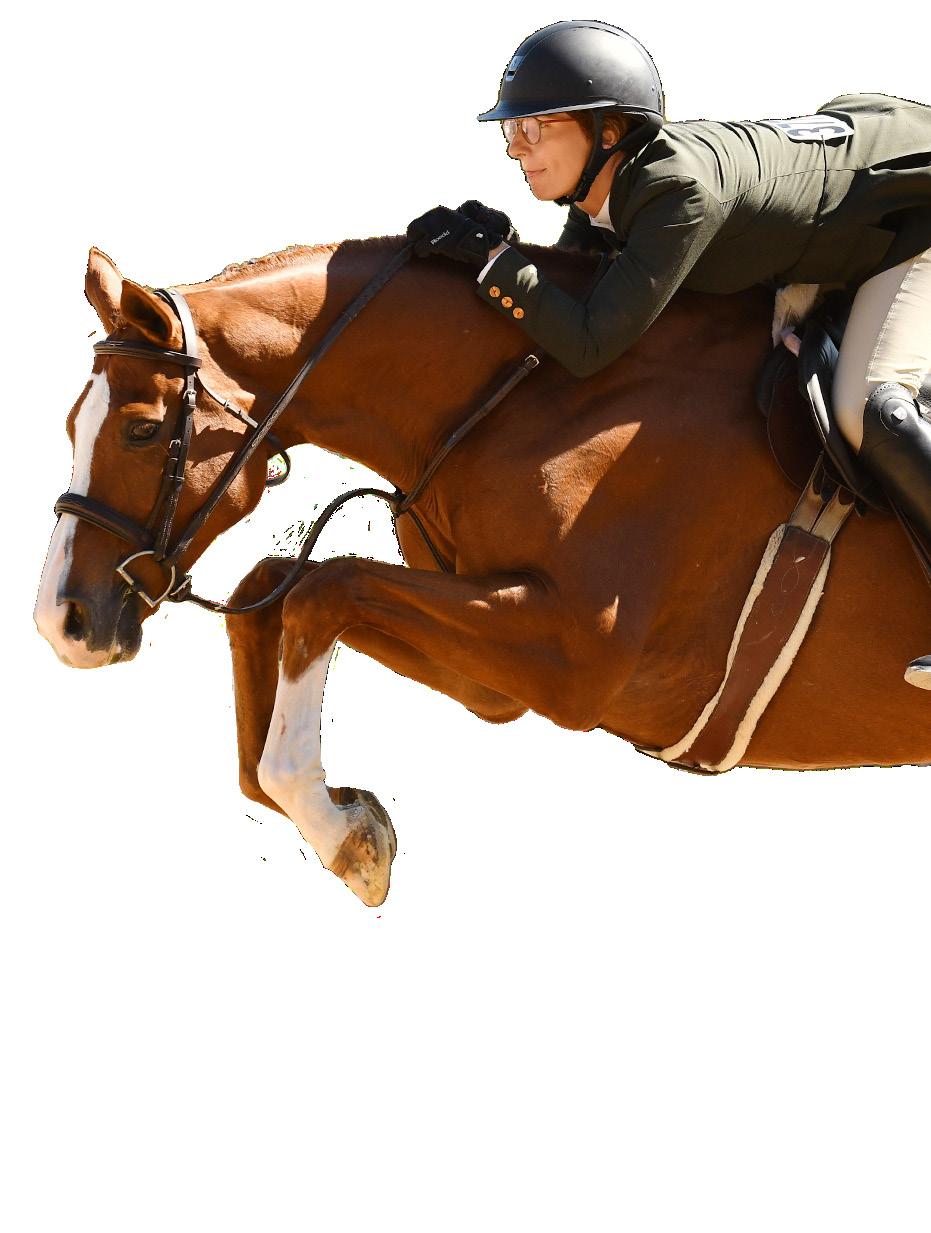
and Ziggy entered the Opportunity classes at Training Level in a local recognized show, and they scored in the low-mid 60-percent range. At their next schooling show, the pair scored over 70 percent at Training 3 to win the Adult Medal. Melcher ended up winning a year-end award with the Georgia Dressage and Combined Training Association (GDCTA), her local GMO, at Training Level schooling. He then competed at the Opportunity First Level with solid mid-60s scores, before becoming Nate’s full-time mount.
Today, Nate is showing Ziggy at Training Level and is participating in Dressage4Kids with Lendon Gray in May and September. The pair did the dressage equitation for the first time at Nate’s first rated show this past February. “He did really well,” Melcher said. “People watching the shows are always very curious about Ziggy, because he’s so striking. And with Nate on him, it’s just the cutest thing.”
Dressage, in Ledyard, Conn., hoping to reach the Grand Prix. In October 2023, Hendrick received her gold medal on Puck.
“The first thing I thought was that it wasn’t just me who got the gold medal, Puck and I did it together,” Hendrick said. “You have to remember that most dressage horses are over 16 hh, but Puck’s small stature made some of the Grand Prix movements like tempis across the diagonal and the canter zig zag much easier.” She also recalls people commenting: “Oh, what breed is that? He’s so cute!”
“When you ride a non-typical breed, you have to ride for yourself and your horse,” Hendrick advised. “I knew Puck wasn’t going to be a high 70-percent-scoring horse, but we were still very successful. And now he loves being a teacher.” Today, Puck is retired from showing, living at Maverick Hill, Conn., and doing First and Second Level with a young rider who is leasing him.
When talking with riders who have chosen unconventional breeds, they all make it clear: a willing temperament, correct training, and naturally good gaits combined with precise equitation go a long way. Judges who assess on that basis should reward those traits no matter the breed.

Amateur Grand Prix dressage rider Kelly Hendrick married into a family of Morgan breeders. Her husband’s parents are Pete and Sandra Hendrick of Queens River Farm in Exeter, R.I. In 2011, Hendrick imported a warmblood as her main show horse, but then along came a 15 hh Morgan at Queens River Farm, named Queens Moody Blues “Puck.”


“Puck was a horse that didn’t fit into their program. I thought ‘I’m going to make him into a dressage horse, as an investment; I’ll train him and roll him over,’” she said. “But I had so much fun on Puck, I ended up keeping him and selling the warmblood.”
Although he’d had some saddle seat training, Hendrick basically started Puck from scratch. Before long, the pair was competing at Training Level and Hendrick earned a silver medal. Then, she began working with trainers Gwyneth McPherson, of Forward Thinking Dressage, based in Williston, Fla., and Jordan LaPlaca, of Maverick Hill
Wallace praised Wyeth’s willingness to do anything for her, even if his body type and style are not the “norm” for eventing. “There’s something magical about working with a Mustang. To learn to trust you and let go of their fears — that’s a big deal,” she said. “Mustangs have taught me just to listen a little bit better.” Beck echoes that sentiment when describing how safe she feels during challenging sections of endurance rides on her Cloudy: “He never does anything stupid. He has a great brain, and I never feel unsafe with him.”
Hendrick emphasized the importance of Puck’s work with skilled dressage trainers McPherson and LaPlaca, and her own desire to make the most of his natural abilities. “Puck’s work ethic was impeccable, and he was so trainable and rideable. He has the biggest heart, and would do absolutely anything for me,” she said. She also credits the Morgan breed for its unusually adaptable and versatile nature, as well as the benefits of its compact build and correct gaits.
Melcher stressed the value of adaptability and correctness, saying that her POA dressage pony Ziggy is “dainty, but his canter is really powerful for such a small horse. Once you teach him something and he understands what he’s supposed to do, he gets it. He’s a very smart pony.”
Fortune pointed out that people are routinely surprised to learn that Captain is an OTTB. “Thoroughbreds are a phenomenal breed with tons of heart, try, and athleticism, and just need a patient partner to help them shine,” she said.
“With all the horses I’ve had the privilege to ride, own, and show, I have not experienced that any breed is objectively superior to another,” Fortune concluded.
While the equestrian world can be resistant to unconventional breeds, riders who challenge the status quo and succeed at higher levels help pave the way for greater acceptance of diverse mounts.
Contributed by the Regulation Department unless otherwise indicated. The following official notices are only intended to give penalty information for a given case and not to disclose the factual basis for each violation or penalty. For matters heard by the Hearing Committee, a Hearing Panel decides each case based on the evidence presented at the hearing and takes into account many factors that may raise or lower a given penalty. For example, the Hearing Committee takes into account such things as whether the violation was intentional or unintentional, the nature of the violation, the credibility of witnesses, Penalty Guidelines, penalties in similar cases, past violations of Federation rules by a respondent, and many other mitigating factors.
US Equestrian members can access and search the United States Equestrian Federation Suspension List online at USequestrian.org. Hover over the Compete tab on the homepage. In the menu that appears, click Ineligibility List under Rules, Regulations, and Grievances.
MARIEKE SLIK, of Houston, TX, violated Chapter 7, GR702.1.d, of this Federation, in connection with the Final Chase H/J Horse Show held in Katy, TX, in that on or about November 15, 2024, as Exhibitor and Trainer, after being thrown from the horse during class #920 (Warm Up Hunter), she struck at the horse multiple times with the crop, hitting the horse twice. This appeared to be an emotional response. As a result of being struck, the horse escaped her control and ran loose. After the horse was caught and while still in the competition ring, she proceeded to discipline the horse in a manner objectionable to the Federation. Her conduct was intemperate and unsportsmanlike in violation of the Federation’s rules.
After presenting the information requested by the Federation, interviewing numerous witnesses, and reviewing affidavits and statements, the Federation resolved this matter through an informal resolution with Ms. Slik to which Ms. Slik fully cooperated with the Federation, was represented by Counsel, and took responsibility for her actions. In determining the proper penalty, the Federation took into account the seriousness of the violations and determined that the following penalties were appropriate.
For this violation it was determined pursuant to Chapter 7, GR703.1.b and GR703.1.f, MARIEKE SLIK shall be found not in good standing, suspended from membership, and forbidden from the privilege of taking any part whatsoever in any Licensed Competition for six (6) months and was excluded from all competition grounds (cannot be on grounds from the time participants are admitted on the competition grounds until the last time for departure). For example, suspended individuals may not be on competition grounds during schooling or other such days prior
to the start of the competition for any purpose, including such things as: coaching riders, training or schooling horses, or trailering horses on or o ff competition grounds during Licensed Competitions for that period. Furthermore, suspended individuals are excluded from: (1) competition grounds as an exhibitor, participant, or spectator; (2) from participating in all Federation affairs and activities; (3) from holding or exercising office in the Federation or in any Licensed Competition; and (4) from attending, observing, or participating in any event, forum, meeting, program, clinic, task force, or committee of the Federation, sponsored by or conducted by the Federation, or held in connection with the Federation and any of its activities. Regulations as to suspended persons are set forth in detail in General Rule 704.
The six-month suspension commenced on January 1, 2025, and terminated at midnight on June 30, 2025. Any horse or horses, completely or in part owned, leased, or of any partnership, corporation or stable of hers, or shown in her name or for her reputation (whether such interest was held at the time of the alleged violation or acquired thereafter), was also suspended pursuant to General Rule 703.1.c for the same time period.
MARIEKE SLIK was also fined in the amount of $4,000, pursuant to General Rule 703.1.k.
RACHEL AGEE, of Deale, MD, violated Chapter 8, GR849.2 and Chapter 4, GR414, of this Federation, in connection with the Winter Spectacular V Horse show held in Ocala, FL, in that on or about January 29, 2025 the horse, CIAO (5810714), who was under the care, custody, and control, of Rachel Agee as Trainer and Kari Renahan as Groom, collapsed near the Barn U wash station.
While the collapse was reported to the Competition Veterinarian, it was not reported to the Steward.
Furthermore, Kari Renehan, as Groom, admitted to injecting CIAO on the same morning, prior to the collapse, even though the horse was scheduled to compete within 12 hours in violation of Federation General Rule, 414.
The Federation resolved this matter through an informal resolution with Ms. Agee to which she fully cooperated with the Federation, and took responsibility for her actions. In determining the proper penalty, the Federation took into account the seriousness of the violations and determined that the following penalties were appropriate.
For this violation it was determined pursuant to Chapter 7, GR703.1.b and GR703.1.f, RACHEL AGEE shall be found not in good standing, suspended from membership, and forbidden from the privilege of taking any part whatsoever in any Licensed Competition for one (1) month and was excluded from all competition grounds (cannot be on grounds from the time participants are admitted on the competition grounds until the last time for departure). For example, suspended individuals may not be on competition grounds during schooling or other such days prior to the start of the competition for any purpose, including such things as: coaching riders, training or schooling horses, or trailering horses on or o ff competition grounds during Licensed Competitions for that period. Furthermore, suspended individuals are excluded from: (1) competition grounds as an exhibitor, participant, or spectator; (2) from participating in all Federation affairs and activities; (3) from holding or exercising office in the Federation or in any Licensed Competition; and (4) from attending, observing, or
participating in any event, forum, meeting, program, clinic, task force, or committee of the Federation, sponsored by or conducted by the Federation, or held in connection with the Federation and any of its activities. Regulations as to suspended persons are set forth in detail in General Rule 704.
The one-month suspension commenced on May 6, 2025, and terminated at midnight on June 6, 2025. Any horse or horses, completely or in part owned, leased, or of any partnership, corporation or stable of hers, or shown in her name or for her reputation (whether such interest was held at the time of the alleged violation or acquired thereafter), was also suspended pursuant to General Rule 703.1.c for the same time period.
RACHEL AGEE was also fined in the amount of $1,500, pursuant to General Rule 703.1.k.
KARI RENEHAN , of Wellington, FL violated Chapter 8, GR849.2 and Chapter 4, GR414, of this Federation, in connection with the Winter Spectacular V Horse show held in Ocala, FL, in that on or about January 29, 2025 the horse, CIAO (5810714), who was under the care, custody, and control, of Rachel Agee as Trainer and Kari Renahan as Groom, collapsed near the Barn U wash station. While the collapse was reported to the Competition Veterinarian, it was not reported to the Steward.
Furthermore, Kari Renehan, as Groom, admitted to injecting CIAO with Arnica on the same morning, prior to the collapse, even though the horse was scheduled to compete within 12 hours in violation of Federation General Rule, 414.
The Federation resolved this matter through an informal resolution with Ms. Renehan to which she fully cooperated with the
Federation, and took responsibility for her actions. In determining the proper penalty, the Federation took into account the seriousness of the violations and determined that the following penalties were appropriate.
For this violation it was determined pursuant to Chapter 7, GR703.1.b and GR703.1.f, KARI RENEHAN shall be found not in good standing, suspended from membership, and forbidden from the privilege of taking any part whatsoever in any Licensed Competition for one (1) month and was excluded from all competition grounds (cannot be on grounds from the time participants are admitted on the competition grounds until the last time for departure). For example, suspended individuals may not be on competition grounds during schooling or other such days prior to the start of the competition for any purpose, including such things as: coaching riders, training or schooling horses, or trailering horses on or o ff competition grounds during Licensed Competitions for that period. Furthermore, suspended individuals are excluded from: (1) competition grounds as an exhibitor, participant, or spectator; (2) from participating in all
Federation affairs and activities; (3) from holding or exercising office in the Federation or in any Licensed Competition; and (4) from attending, observing, or participating in any event, forum, meeting, program, clinic, task force, or committee of the Federation, sponsored by or conducted by the Federation, or held in connection with the Federation and any of its activities. Regulations as to suspended persons are set forth in detail in General Rule 704.
The one-month suspension commenced on May 6, 2025, and terminated at midnight on June 6, 2025. Any horse or horses, completely or in part owned, leased, or of any partnership, corporation or stable of hers, or shown in her name or for her reputation (whether such interest was held at the time of the alleged violation or acquired thereafter), was also suspended pursuant to General Rule 703.1.c for the same time period.
KARI RENEHAN was also fined in the amount of $1,500, pursuant to General Rule 703.1.k.
DENNIS MITCHELL, of Reddick, FL violated the USEF Safe Sport Policy, III. Prohibited Conduct, A. Emotional and Physical Misconduct, 3. Bullying Behavior
of this Federation, in that on or about September 30, 2024, at Golden Gate Equestrian Center in Jordan, Minnesota, he engaged in behaviors that violate the USEF Safe Sport Policy when he became verbally abusive and threatening towards a minor athlete.
The Federation resolved this matter through an informal resolution with Mr. Mitchell following an investigation and review, in which Mr. Mitchell fully cooperated with the Federation and was represented by Counsel. In determining the proper penalty, the Federation took into account the facts and mitigating factors in this case and determined that the following penalties were appropriate.
For this violation it was determined that pursuant to Chapter 7, GR703.1b and GR703.1f, DENNIS MITCHELL shall be found not in good standing, suspended from membership, and forbidden from the privilege of taking any part whatsoever in any Licensed Competition for one month and was excluded from all competition grounds (cannot be on grounds from the time participants are admitted on the competition grounds until the last time for departure). For example, suspended individuals may not
be on competition grounds during schooling or other such days prior to the start of the competition for any purpose, including such things as: coaching riders, training or schooling horses, or trailering horses on or off competition grounds during Licensed Competitions. Furthermore, suspended individuals are excluded from: (1) competition grounds as an exhibitor, participant, or spectator; (2) from participating in all Federation affairs and activities; (3) from holding or exercising office in the Federation or in any Licensed Competition; and (4) from attending, observing, or participating in any event, forum, meeting, program, clinic, task force, or committee of the Federation, sponsored by or conducted by the Federation, or held in connection with the Federation and any of its activities. Regulations as to suspended persons are set forth in detail in General Rule 704.
The one-month suspension commenced on April 1, 2025, and terminated at midnight on April 30, 2025. Any horse or horses owned, leased, or of any partnership, corporation or stable of his, or shown in his name or for his reputation, (whether such interest was held at the time of



the alleged violation or acquired thereafter), was also suspended, pursuant to Chapter 7, GR703.1c for the same period.
This is official notice of actions taken by the United States Equestrian Federation, Inc. Hearing Committee on March 26, 2025.
TOMMI CLARK, of Columbus, NC, as Trainer, agent, or other Person Responsible as defined by GR148 and GR404, violated Chapter 4, GR410, of this Federation, in connection with the Tryon Spring 5 Horse Show held May 28–June 2, 2024, in that on or about May 31, 2024, the horse, P.S. LIMITED EDITION, was exhibited after it had been administered and/or contained in its body the parent acepromazine and its metabolite, 2-(1-hydroxyethyl) promazine sulfoxide, and the parent detomidine and its metabolite 3-carboxydetomidine.
During a Zoom video hearing, the Hearing Panel gave consideration to the written submissions and evidence submitted by the parties as well as testimony of the parties and witnesses. Ms. Clark was given proper notice of the Complaint and hearing and was represented by Counsel. Through documentary evidence and the live testimony of expert witnesses, the Federation met its burden of establishing violations of GR410 with regard to acepromazine and its metabolite, and also with regard to detomidine and its metabolite. Ms. Clark took issue with the manner in which P.S. LIMITED EDITION was selected for testing, claiming that the Federation improperly “targeted” her for testing. Based on the evidence in the record, the Hearing Panel determined unanimously that Ms. Clark failed to establish any impropriety in the selection of P.S. LIMITED EDITION for testing, and lacking any other challenge to the Federation’s case, the Hearing Panel ruled unanimously that Respondents violated Federation rules as charged.
In determining the proper penalty for the violations, the Hearing Panel considered Ms. Clark’s argument that no penalty should be levied because the Federation acted unfairly by not apprising Ms. Clark of the instant analytical results prior to her signing and agreeing to an informal resolution in a separate violation. However, there was insufficient proof to support the claim that the appropriate decisionmaker(s) in the Federation were aware of the analytical findings prior to submitting the Offer of Informal Resolution to Ms. Clark.
The Hearing Panel further considered the evidence that Ms. Clark
had access to both medications and to syringes and needles, and knew how to administer these medications. Based on the testimony of the Federation’s expert witnesses, the analytical results strongly supported intentional doping of the horse, with claims of contamination or sabotage being remote at best. The experts testified about the rarity of finding both parent drugs in the blood sample, which logically tied the administration to within mere hours before the horse competed. Indeed, the finding in the blood sample of not one, but two, Prohibited Substances with different pharmacological effects was discussed by both experts as a matter of great concern, and led them to conclude in this factual context that intentional doping was highly likely. Acepromazine and detomidine work at “different ends of the spectrum” and are not usually given together for therapeutic reasons, and the experts agreed on the dangers presented by these medications to the health of the horse, as well as the negative impacts of “taking the edge off” a horse in terms of fair competition and safety at Licensed Competitions. While either medication can be used for a recognized therapeutic purpose with the filing of a Medication Report Form, there were no Medication Report Forms submitted and no testimony offered that either medication was administered to P.S. LIMITED EDITION for a legitimate therapeutic purpose.
Based on the proof in this case, the Hearing Panel ruled unanimously that the evidence surrounding the administrations of acepromazine and detomidine placed this case squarely within the Drugs & Medications Penalty Guidelines (“Penalty Guidelines”) for a second offense in Category II. The presence of two Prohibited Substances and the other concerning factors discussed above led the Hearing Panel to unanimously set the following significant penalties.
For these second offense violations under Category II of the Penalty Guidelines it was determined that pursuant to Chapter 7, GR703.1.b and GR703.1.f, TOMMI CLARK shall be found not in good standing, suspended from membership, and forbidden from the privilege of taking any part whatsoever in any Licensed Competition for seven (7) months and is excluded from all Competition grounds (cannot be on grounds from the time participants are admitted on the Competition grounds until the last time for departure). For example, suspended individuals may not be on Competition grounds during schooling or other such days prior to the start of the Competition
for any purpose, including such things as: coaching riders, training or schooling horses, or trailering horses on or off Competition grounds during Licensed Competitions for that period. Furthermore, suspended individuals are excluded: (1) from competition grounds as an exhibitor, participant or spectator; (2) from participating in all Federation affairs and activities; (3) from holding or exercising office in the Federation or in any Licensed Competition; and (4) from attending, observing, or participating in any event, forum, meeting, program, clinic, task force, or committee of the Federation, sponsored by or conducted by the Federation, or held in connection with the Federation and any of its activities. Regulations as to suspended persons are set forth in detail in General Rule 704.
The seven-month suspension commenced on May 8, 2025, and terminate at midnight on December 8, 2025. Any horse or horses owned, leased, or of any partnership, corporation or stable of hers, or shown in her name or for her reputation (whether such interest was held at the time of the alleged violation or acquired thereafter), shall also be suspended, pursuant to Chapter 7, GR703.1.c, for the same period.
TOMMI CLARK was also fined $7,000, pursuant to Chapter 7, GR703.1.k. Furthermore, in connection with this penalty all trophies, prizes, ribbons, and monies, if any, won by P.S. LIMITED EDITION at said competition were redistributed pursuant to Chapter 7, GR703.1.h.
VICTOR RODRIGUEZ , of Medellin, Columbia, as Trainer, violated Chapter 4, GR410 and GR411, of this Federation, in connection with the Ocala Cup Horse Show held December 13-15, 2024, in that the horse, CONDESA DE HH, was exhibited after it had been administered and/or contained in its body propranolol and 4-hydroxypropanolol. The facts and mitigating factors in this case supported the following penalty even though it is below the suggested range for Category III Violations outlined in the Drugs and Medications Penalty Guidelines.
For this violation it was determined that pursuant to Chapter 7, GR703.1.b and GR703.1.f, VICTOR RODRIGUEZ shall be found not in good standing, suspended from membership, and forbidden from the privilege of taking any part whatsoever in any Licensed Competition for three (3) months and is excluded from all Competition grounds (cannot be on grounds from the time participants
are admitted on the Competition grounds until the last time for departure). For example, suspended individuals may not be on Competition grounds during schooling or other such days prior to the start of the Competition for any purpose, including such things as: coaching riders, training or schooling horses, or trailering horses on or off Competition grounds during Licensed Competitions for that period. Furthermore, suspended individuals are excluded from: competition grounds as (1) an exhibitor, participant or spectator; (2) from participating in all Federation affairs and activities; (3) from holding or exercising office in the Federation or in any Licensed Competition; and (4) from attending, observing, or participating in any event, forum, meeting, program, clinic, task force, or committee of the Federation, sponsored by or conducted by the Federation, or held in connection with the Federation and any of its activities. Regulations as to suspended persons are set forth in detail in General Rule 704.
The three-month suspension shall commence on December 1, 2025, and terminate at midnight on February 28, 2026. Any horse or horses owned, leased, or of any partnership, corporation or stable of his, or shown in his name or for his reputation (whether such interest was held at the time of the alleged violation or acquired thereafter), shall also be suspended, pursuant to Chapter 7, GR703.1.c, for the same period.
VICTOR RODRIGUEZ was also fined $3,000, pursuant to Chapter 7, GR703.1.k. In connection with this penalty all trophies, prizes, ribbons, and monies, if any, won by CONDESA DE HH at said competition were redistributed pursuant to Chapter 7, GR703.1.h.
JAIMEE ROSENTHAL , of Charlotte, NC, as Trainer, violated Chapter 4, GR410 and GR411, of this Federation, in connection with the Winter Premier Horse Show held January 17-19, 2025, in that the horse, MISTERY VAN DE SMISHOEVE, was exhibited after it had been administered and/or contained in its body flunixin and phenylbutazone.
For this violation it was determined that JAIMEE ROSENTHAL be censured pursuant to Chapter 7, GR703.1.a and fined $1,500 pursuant to Chapter 7, GR703.1.k. It was further directed that for this violation of the rules, all trophies, prizes, ribbons, and monies, if any, won by MISTERY VAN DE SMISHOEVE at said competition must be redistributed pursuant to Chapter 7, GR703.1.h.
BRAYAN LOZADA-ESPINO , of Ocala, FL, as Trainer, violated Chapter 4, GR410 and GR411, of this Federation, in connection with the Ocala Cup Horse Show held December 13-15, 2024, in that the horse, FANTASIA DE YARUMALITO, was exhibited after it had been administered and/or contained in its body flunixin and phenylbutazone. The plasma concentration of phenylbutazone exceeded the maximum permitted level.
For this violation it was determined that BRAYAN LOZADA-ESPINO be censured pursuant to Chapter 7, GR703.1.a and fined $2,000 pursuant to Chapter 7, GR703.1.k. It was further directed that for this violation of the rules, all trophies, prizes, ribbons, and monies, if any, won by FANTASIA DE YARUMALITO at said competition must be redistributed pursuant to Chapter 7, GR703.1.h.
MICHELLE JARUS, of Brook Park, OH, violated Chapter 4, GR410-411, of this Federation, in connection with the World Equestrian Center Winter Classic #3 Horse Show held December 11-15, 2024, in that she, as Trainer, exhibited the horse, ARPEGGIO, after it had been administered and/ or contained in its body cetirizine. The facts and mitigating factors in this case supported the following penalty even though it is below the suggested range for Category II Violations outlined in the Drugs and Medications Penalty Guidelines.
For this violation it was determined that MICHELLE JARUS be censured pursuant to Chapter 7, GR703.1.a and fined $1,500, pursuant to Chapter 7, GR703.1.k. It was further directed that for this violation of the rules, all trophies, prizes, ribbons, and monies, if any, won by ARPEGGIO at said competition must be redistributed pursuant to Chapter 7, GR703.1.h.
ROBERT HUNT, of Monroe, NC, violated Chapter 4, GR410 – GR411, of this Federation, in connection with the Ocala Winter Classic Horse Show held February 4 – 9, 2025, in that he, as Trainer, exhibited the horse, SELECT, after it had been administered and/or contained in its body acepromazine and 2(1-hydroxyethyl) promazine sulfoxide.
For this violation it was determined that pursuant to Chapter 7, GR703.1b and GR703.1f, ROBERT HUNT shall be found not in good standing, suspended from membership, and forbidden from the privilege of taking any part whatsoever in any Licensed Competition for two (2) months and is excluded from all Competition grounds (cannot be on grounds from the time participants are admitted on the
Competition grounds until the last time for departure). For example, suspended individuals may not be on Competition grounds during schooling or other such days prior to the start of the Competition for any purpose, including such things as: coaching riders, training or schooling horses, or trailering horses on or off Competition grounds during Licensed Competitions for that period. Furthermore, suspended individuals are excluded from: competition grounds as (1) an exhibitor, participant or spectator; (2) from participating in all Federation affairs and activities; (3) from holding or exercising office in the Federation or in any Licensed Competition; and (4) from attending, observing, or participating in any event, forum, meeting, program, clinic, task force, or committee of the Federation, sponsored by or conducted by the Federation, or held in connection with the Federation and any of its activities. Regulations as to suspended persons are set forth in detail in General Rule 704.
The two-month suspension shall commence on January 1, 2026, and terminate at midnight on February 28, 2026. Any horse or horses owned, leased, or of any partnership, corporation or stable of his, or shown in his name or for his reputation (whether such interest was held at the time of the alleged violation or acquired thereafter), shall also be suspended, pursuant to Chapter 7, GR703.1c, for the same period.
ROBERT HUNT was also fined $3,000, pursuant to Chapter 7, GR703.1j. In connection with this penalty all trophies, prizes, ribbons, and monies, if any, won by SELECT at said competition were redistributed pursuant to Chapter 7, GR703.1g.
LUCIANA SOLARI of Castle Rock, CO, as Trainer, violated Chapter 4, GR410 of this Federation, in connection with the Desert Circuit 8 Horse Show held on February 26-March 2, 2025, in that the horse, JOTA-E-BALOON, was exhibited after it had been administered and/or contained in its body dexamethasone in a plasma concentration exceeding the maximum permitted level.
For this violation it was determined that LUCIANA SOLARI be censured pursuant to Chapter 7, GR703.1a and fined $1,500 pursuant to Chapter 7, GR703.1j. It was further directed that for this violation of the rules, all trophies, prizes, ribbons, and monies, if any, won by JOTA-E-BALOON at said competition must be redistributed pursuant to Chapter 7, GR703.1g.
KAREN PERLOW , of Burbank, CA, violated Chapter 4,




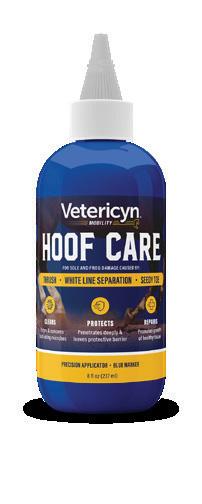


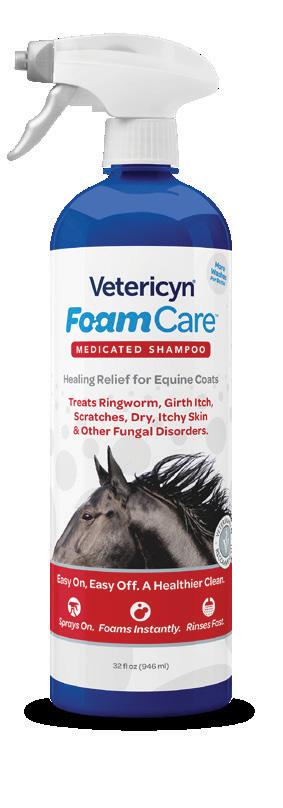

Vetericyn® makes the most advanced, effective, and safe products to keep horses healthy. Whether it’s cleaning wounds, treating hoof or eye issues, or conditioning and cleaning the coat, horse lovers trust Vetericyn for total equine wellness.
GR410-411, of this Federation, in connection with the Desert Circuit 4 Horse Show held January 28–February 2, 2025, in that she, as Trainer, exhibited the horse, SEASIDE, after it had been administered and/or contained in its body pentoxifylline.
For this violation it was determined that KAREN PERLOW be censured pursuant to Chapter 7, GR703.1.a and fined $1,500, pursuant to Chapter 7, GR703.1.k. It was further directed that for this violation of the rules, all trophies, prizes, ribbons, and monies, if any, won by SEASIDE at said competition must be redistributed pursuant to Chapter 7, GR703.1.h.
KAITLYN MORRIS, of Chapel Hill, TN, violated Chapter 4, GR411, of this Federation, in connection with the WEC Ocala December #2 Horse Show held December 11-15, 2024, in that she, as Trainer, failed to properly file an Equine Drugs and Medications Report Form documenting the administration of hydroxyzine and cetirizine prior to exhibiting the horse, CONTIDA HELDENLAAN Z.
For this violation it was determined that KAITLYN MORRIS be censured pursuant to Chapter 7, GR703.1.a and fined $1,000, pursuant to Chapter 7, GR703.1.k.
VICTORIA IMBRIGLIO-BARNES of Peachtree City, GA, violated Chapter 4, GR410 of this Federation, in connection with the Winter Fest Horse Show held on February 20–23, 2025, in that she, as Trainer, exhibited the horse, CHINA COVE, was exhibited after it had been administered and/or contained in its body methocarbamol in a plasma concentration exceeding the maximum permitted level.
For this violation it was determined that VICTORIA IMBRIGLIO-BARNES be censured pursuant to Chapter 7, GR703.1a and fined $1,000 pursuant to Chapter 7, GR703.1k. It was further directed that for this violation of the rules, all trophies, prizes, ribbons, and monies, if any, won by CHINA COVE, at said competition must be redistributed pursuant to Chapter 7, GR703.1g.
STACEY WEISS, of Westminster, MD, violated Chapter 4, GR411.1.i, of this Federation, in connection with the Winter Spectacular VI Horse Show held February 4 – 9, 2025, in that she, as Trainer, failed to properly file an Equine Drugs and Medications Report Form documenting the administration of triamcinolone acetonide prior to exhibiting the horse, ELINEA VDL.
For this violation it was determined that STACEY WEISS be censured pursuant to Chapter 7, GR703.1.a and fined $1,500, pursuant to Chapter 7, GR703.1.k.
SELINA PETRONELLI of Churchville, MD violated Chapter 4, GR410 of this Federation, in connection with the McDonogh Winter Classic III Horse Show held on February 21–23, 2025, in that as Trainer, she exhibited the horse, PEACE TALK, was exhibited after it had been administered and/or contained in its body methocarbamol in a plasma concentration exceeding the maximum permitted level.
For this violation it was determined that SELINA PETRONELLI be censured pursuant to Chapter 7, GR703.1a and fined $1,000 pursuant to Chapter 7, GR703.1k. It was further directed that for this violation of the rules, all trophies, prizes, ribbons, and monies, if any, won by PEACE TALK, at said competition must be redistributed pursuant to Chapter 7, GR703.1g.
ANN DOTOLI, of Chepachet, RI, violated Chapter 4, GR410, of this Federation, in connection with the HITS on the Hudson VII Horse Show held August 28–September 1, 2024, in that she, as Trainer, exhibited the horse, AXE SPB Z, after it had been administered and/or it contained in its body flunixin in a plasma concentration exceeding the maximum permitted level.
For this violation it was determined that ANN DOTOLI be censured pursuant to Chapter 7, GR703.1.a and fined $1,000, pursuant to Chapter 7, GR703.1.k. In connection with this penalty all trophies, prizes, ribbons, and monies, if any, won by AXE SPB Z at said competition were redistributed pursuant to Chapter 7, GR703.1.h.
MICHAEL BRITT-LEON, of Alpharetta, GA, violated Chapter 4, GR410, of this Federation, in connection with the New Direction Summer Classic Horse Show held July 25-28, 2024, in that as Trainer, he exhibited the horse, FAIR PLAY, after it had been administered and/or contained in its body romifidine.
For this violation it was determined that pursuant to Chapter 7, GR703.1.b and GR703.1.f, MICHAEL BRITT-LEON shall be found not in good standing, suspended from membership, and forbidden from the privilege of taking any part whatsoever in any Licensed Competition for two (2) months and is excluded from all Competition grounds (cannot be on grounds from the time participants are admitted on the Competition grounds until the last time for departure). For example, suspended individuals may not be on Competition grounds during schooling or other such days prior to the start of the Competition for any purpose, including such things as: coaching riders, training or schooling horses, or trailering horses on or off Competition grounds during Licensed Competitions for that period. Furthermore, suspended individuals are excluded from: competition grounds as (1) an exhibitor, participant or spectator; (2) from participating in all Federation affairs and activities; (3) from holding or exercising office in the Federation or in any Licensed Competition; and (4) from attending, observing, or participating in any event, forum, meeting, program, clinic, task force, or committee of the Federation, sponsored by or conducted by the Federation, or held in connection with the Federation and any of its activities. Regulations as to suspended persons are set forth in detail in General Rule 704.
The two-month suspension shall commence on June 1, 2025, and terminate at midnight on July 31, 2025. Any horse or horses owned, leased, or of any partnership, corporation or stable of his, or shown in his name or for his reputation (whether such interest was held at the time of the alleged violation or acquired thereafter), shall also be suspended, pursuant to Chapter 7, GR703.1.c, for the same period.
MICHAEL BRITT-LEON was also fined $3,000, pursuant to Chapter 7, GR703.1.k. In connection with this penalty all trophies, prizes, ribbons, and monies, if any, won by FAIR PLAY at said competition were redistributed pursuant to Chapter 7, GR703.1.h.










• 2024 Intercollegiate Dressage Association National Championships 4th Place Team.
• 2024 Intercollegiate Horse Show Association (IHSA) Western National Championships 8th Place Team.
• 2024 IHSA Cacchione Cup Qualifier.
• 2023 IHSA Area 10 Regional Champion Western Team.
• 2023 Reserve Champion College at the IHSA Holiday Tournament of Champions.
• 2023 IHSA Hunter Seat Equitation National Championships Fifth Place team.
• 2023 Intercollegiate Dressage Association Reserve National Champions.
• 2018 IHSA Hunter Seat Equitation National Championships Reserve Champion team. Our Equestrian Center is home to the following:
• 2017 Intercollegiate Dressage Association Reserve National Champions.
• 2013 Intercollegiate Dressage Association National Champions.
• United States Dressage Federation medalists and USDF-certified instructional staff.
• Leading-edge equine boarding with experienced care from permanent staff.
• Modern facility with two indoor arenas, 200 x 200 outdoor arena, cross-country course, paddocks and miles of trails.
Do you have a student interested in applying? Please contact admissions@mtholyoke.edu
Horse donations or leases are gladly considered. Please contact Ali Ingellis at aingellis@mtholyoke.edu
































professional portfolio, US Equestrian encourages student athletes to include the number of Interscholastic years of achievement. It is important to highlight your dedication and commitment to the program by listing the number of years you were a lettering athlete. US Equestrian also provides athletes the option to send your current school a letter from our president, Tom O’Mara, showcasing your achievements.








Learn more and sign up today! usef.org/go/equestrianathlete








From fungal and bacterial skin issues, to sunburn, wounds and insect bite hypersensitivity, EquiShield ® provides you and your horse with science-backed solutions.



